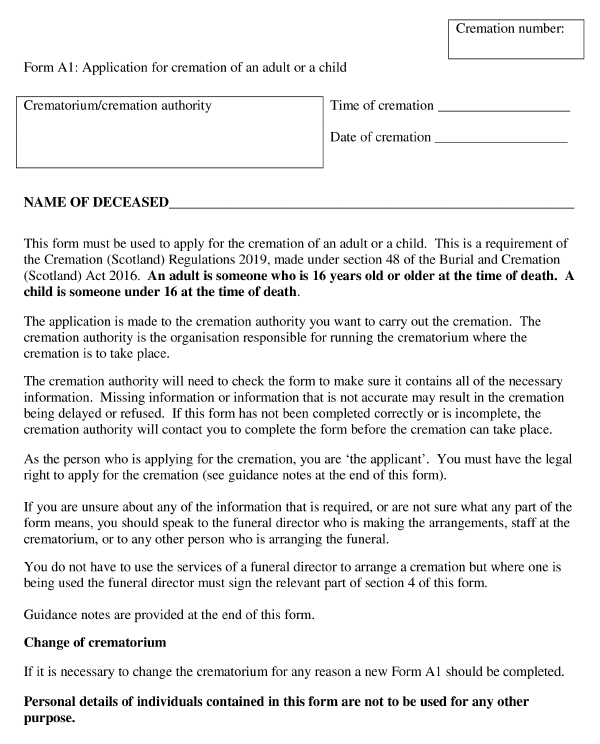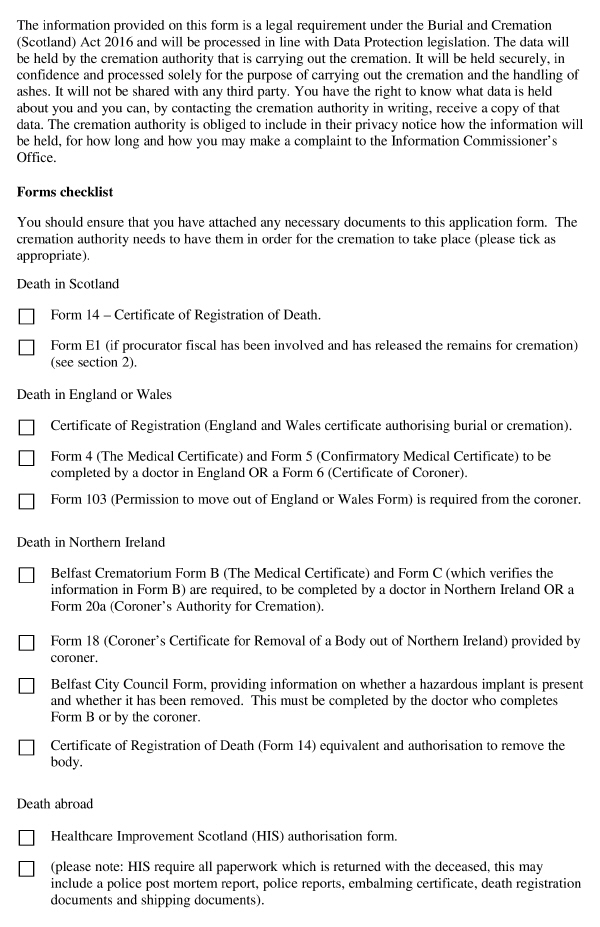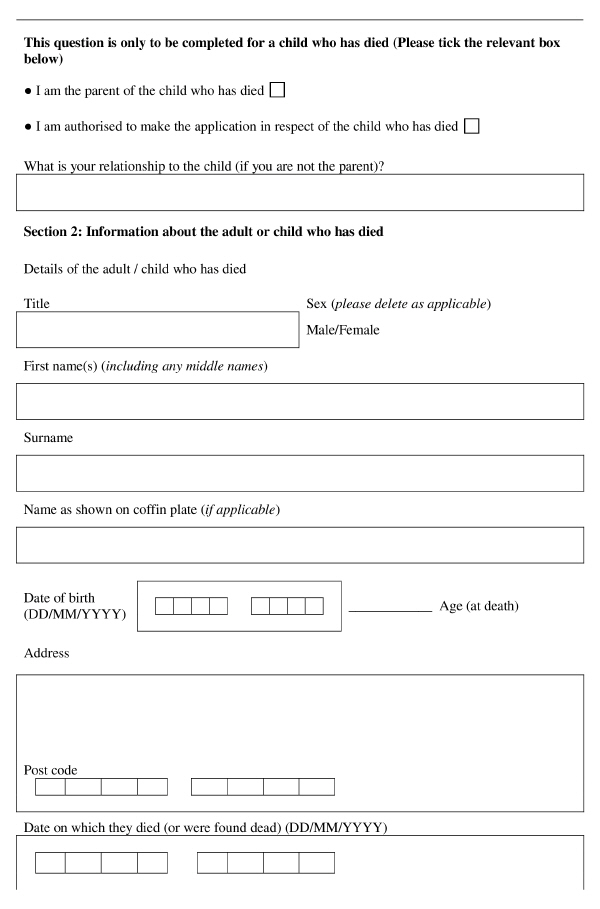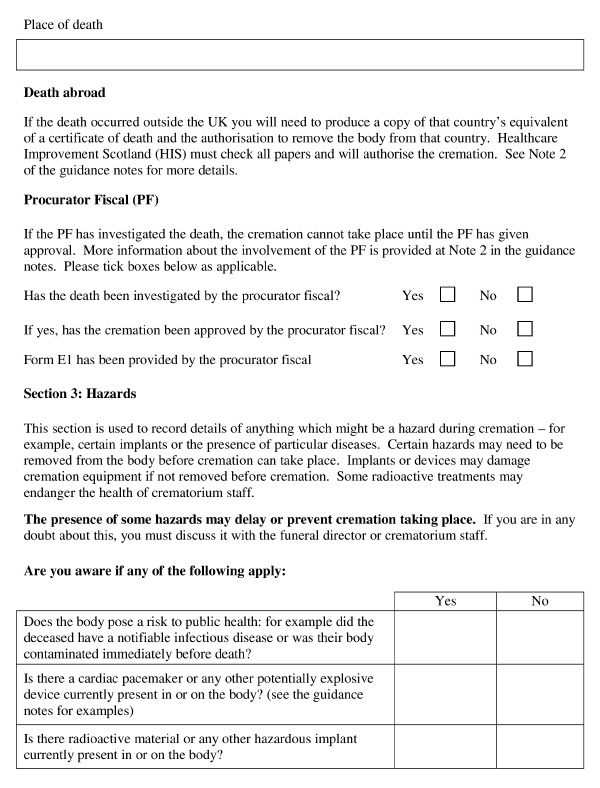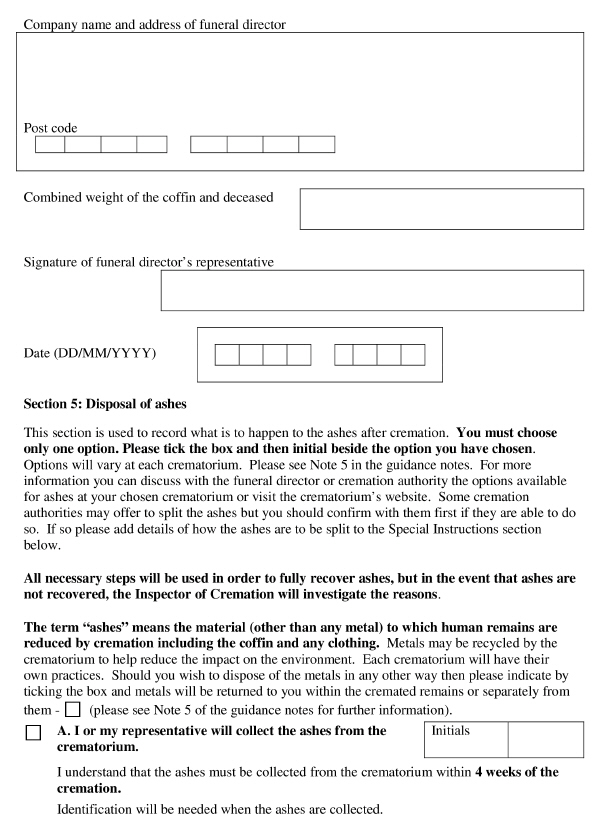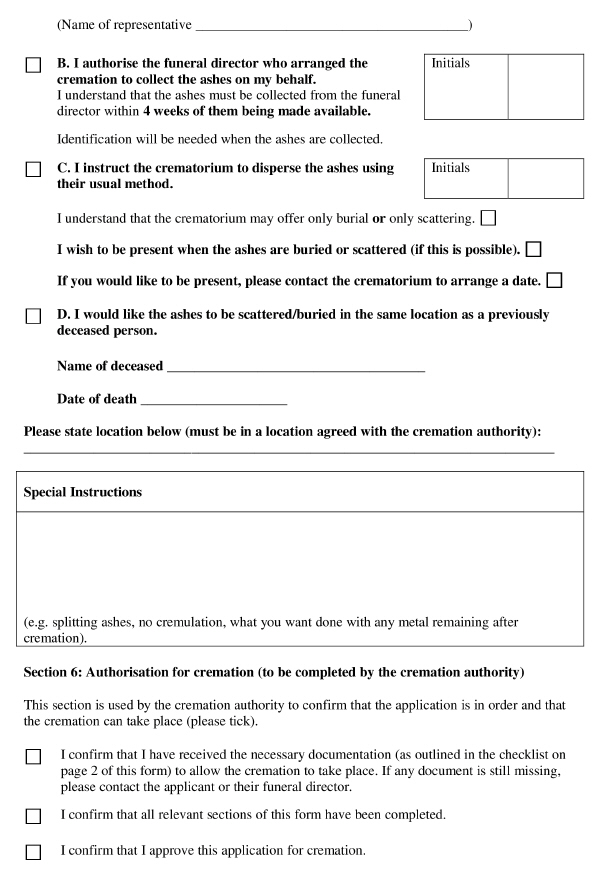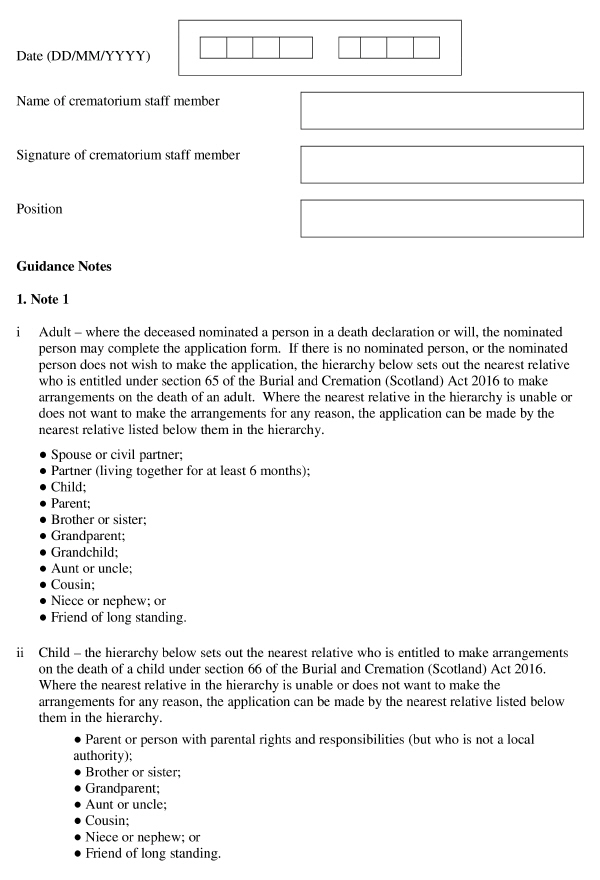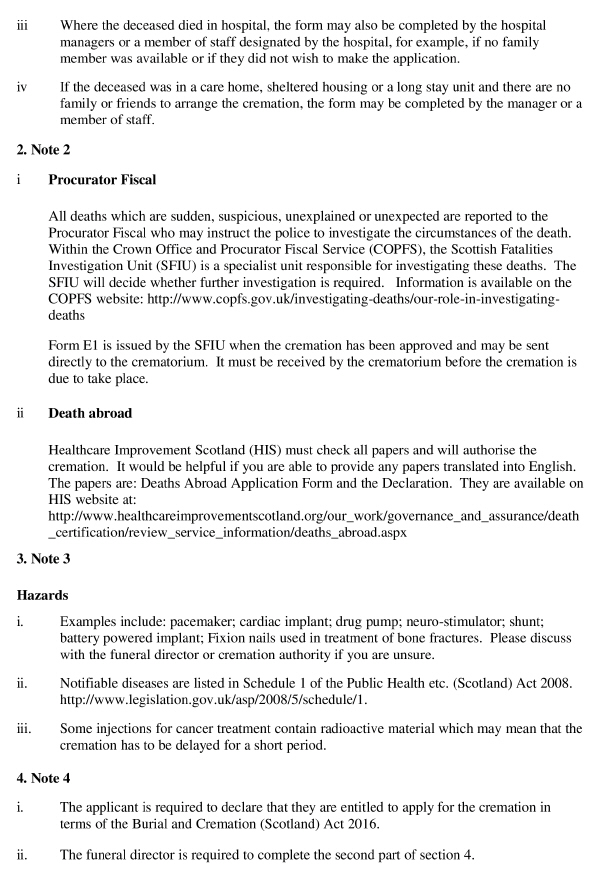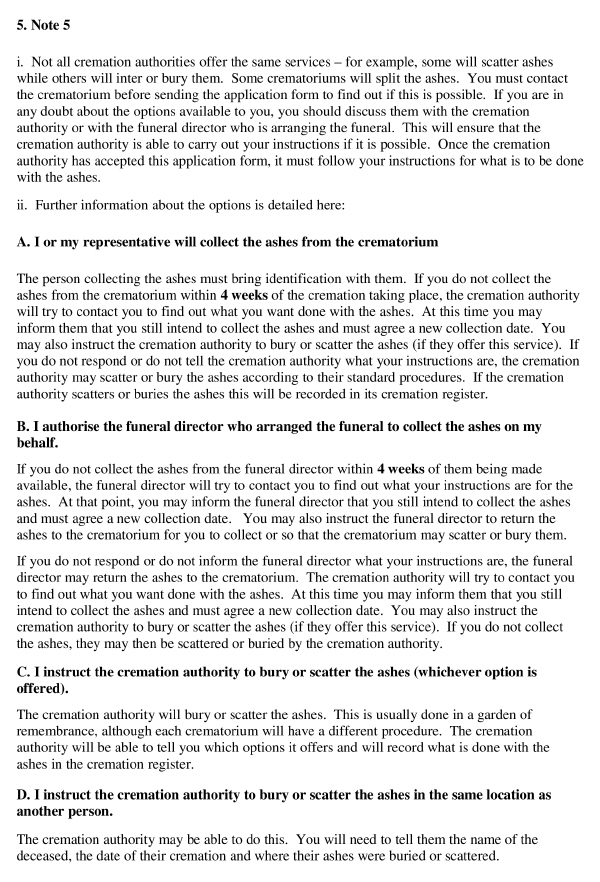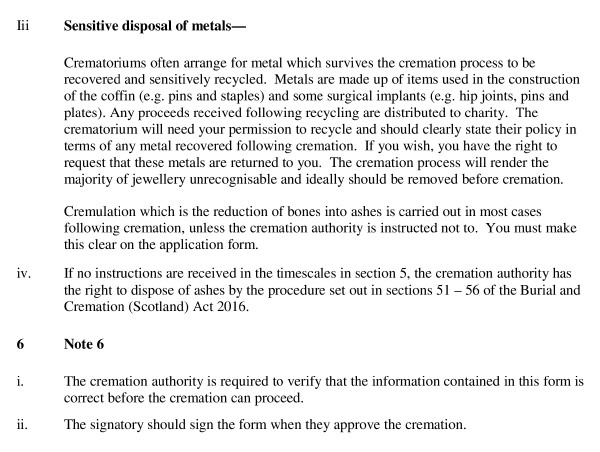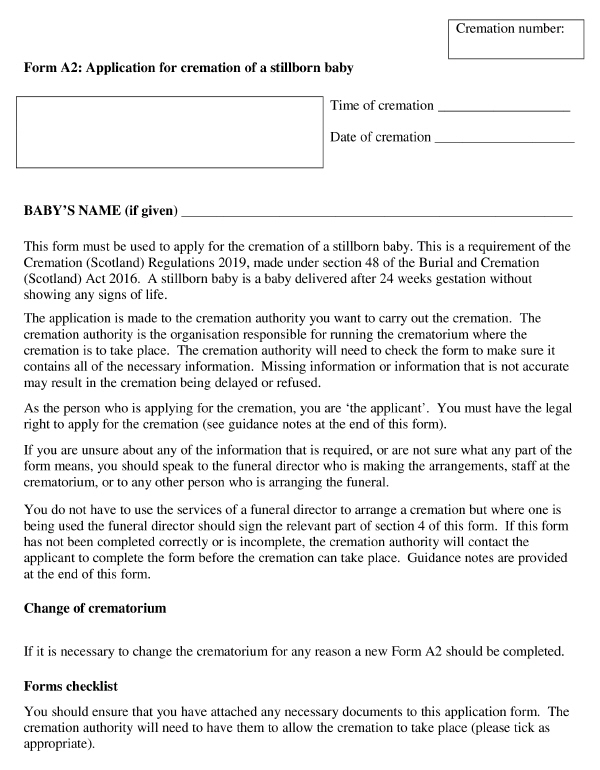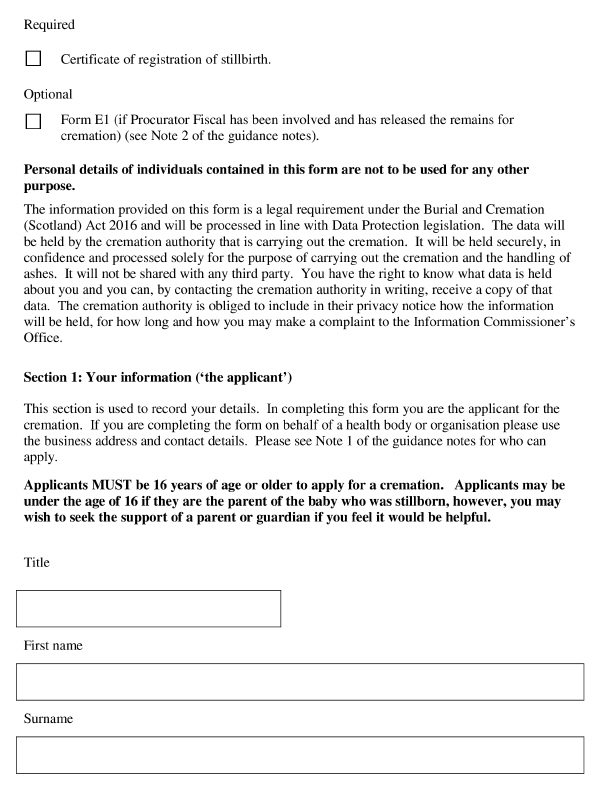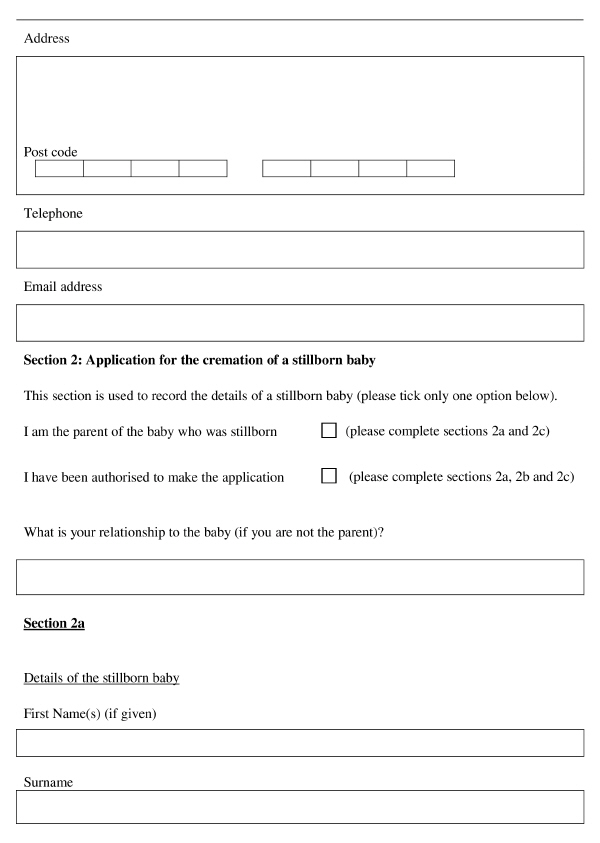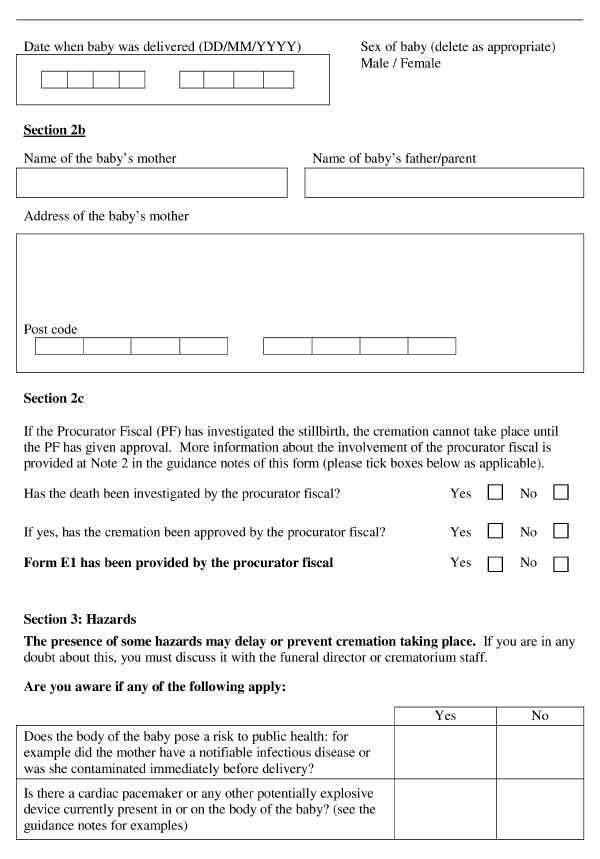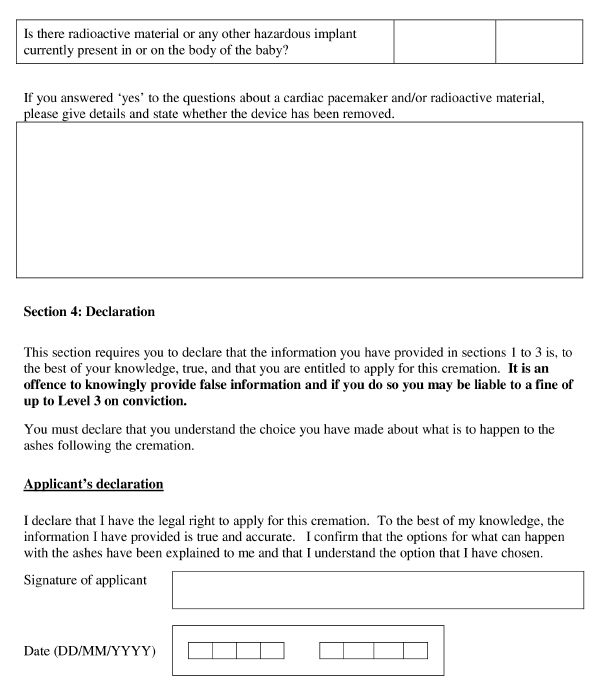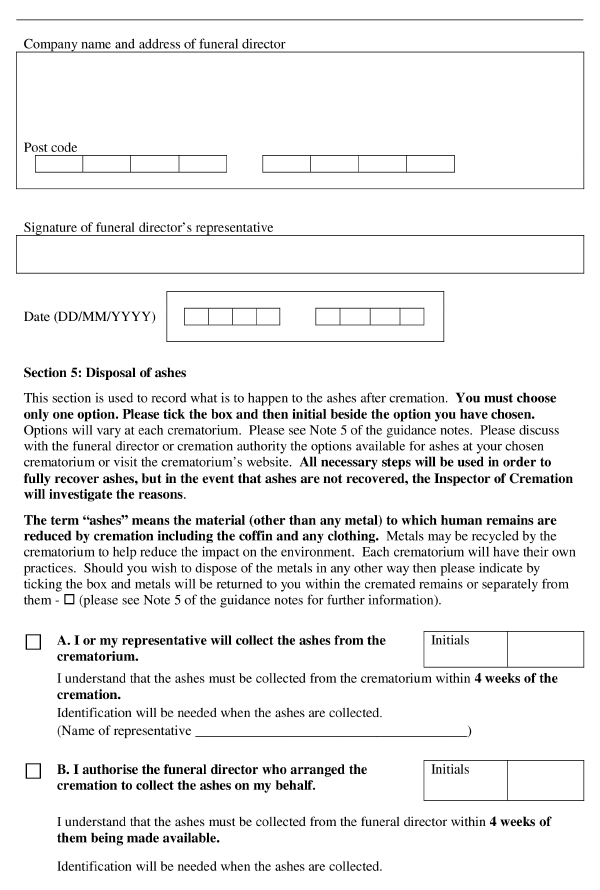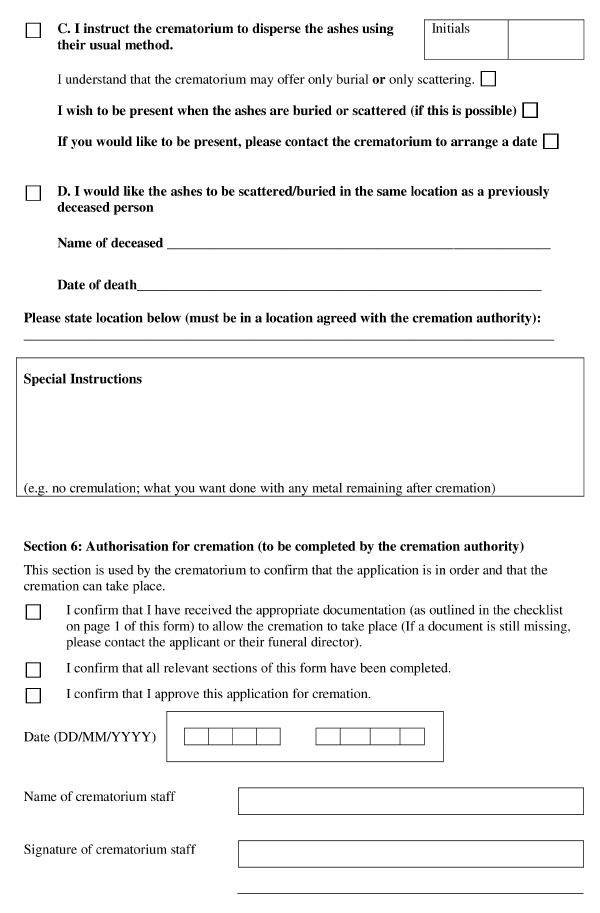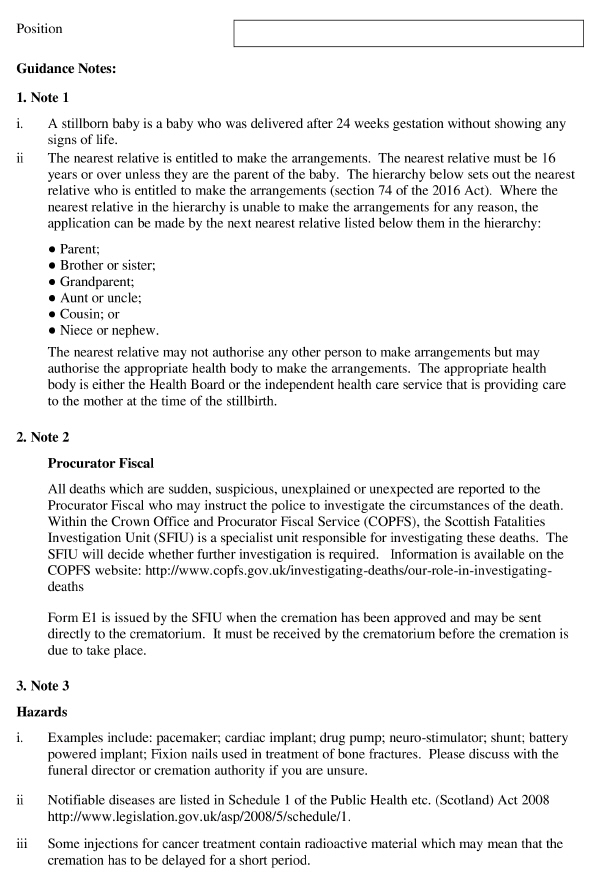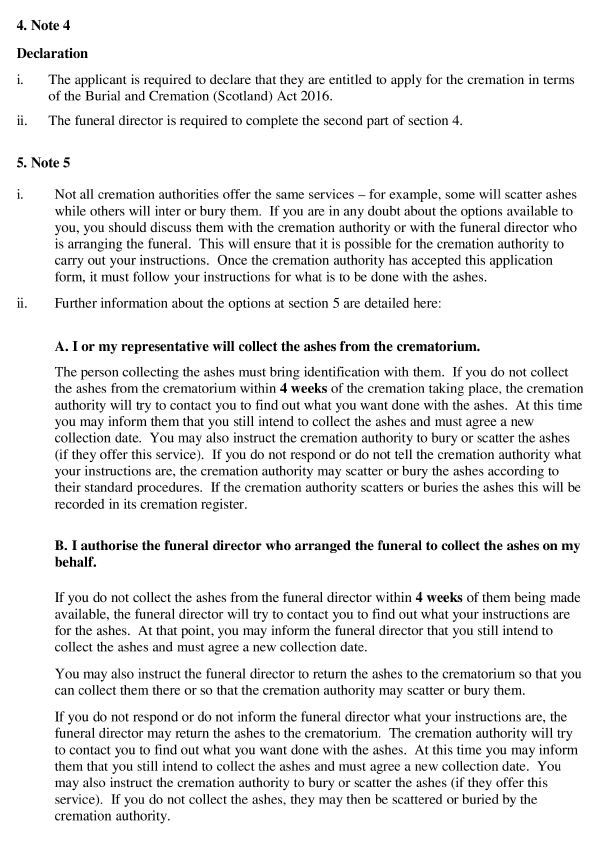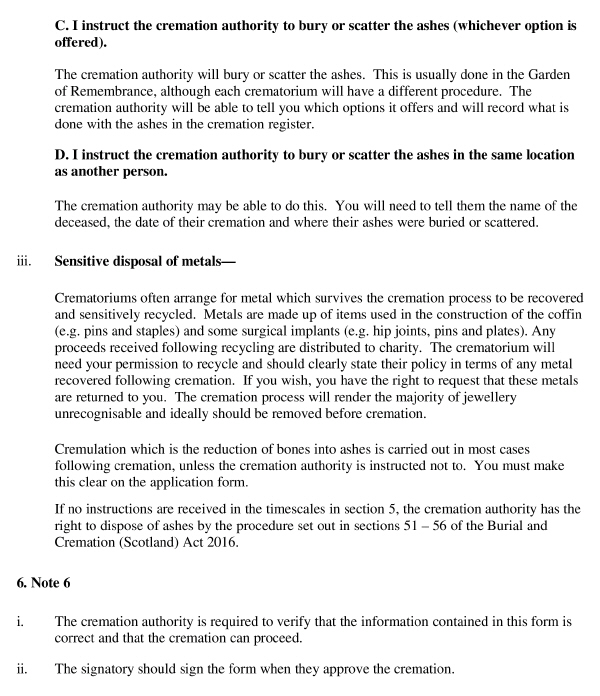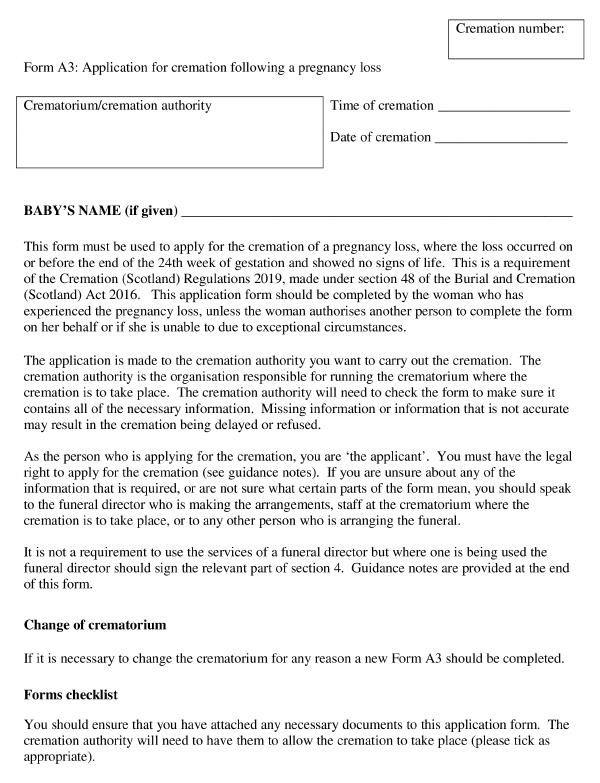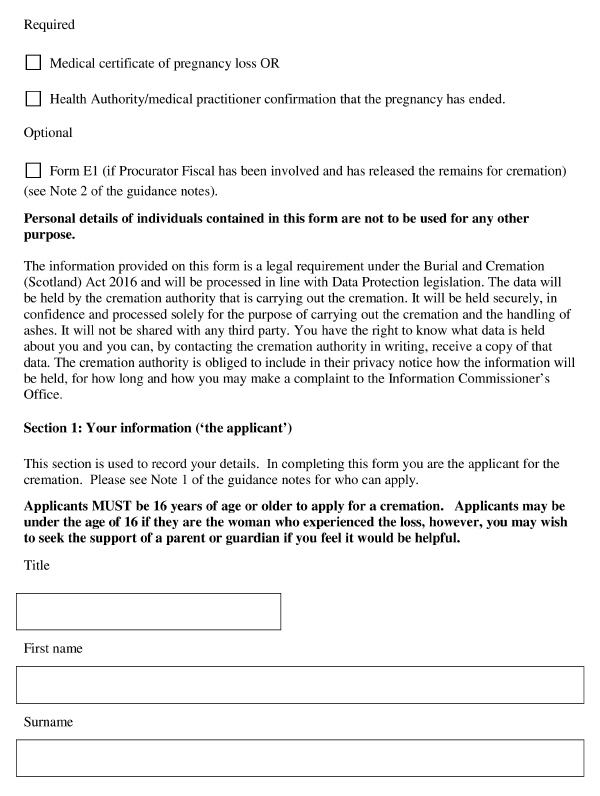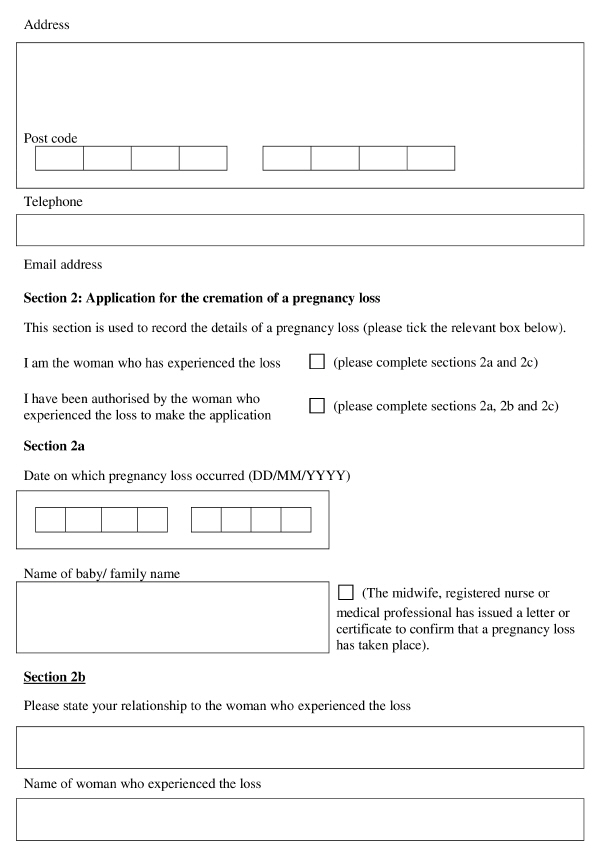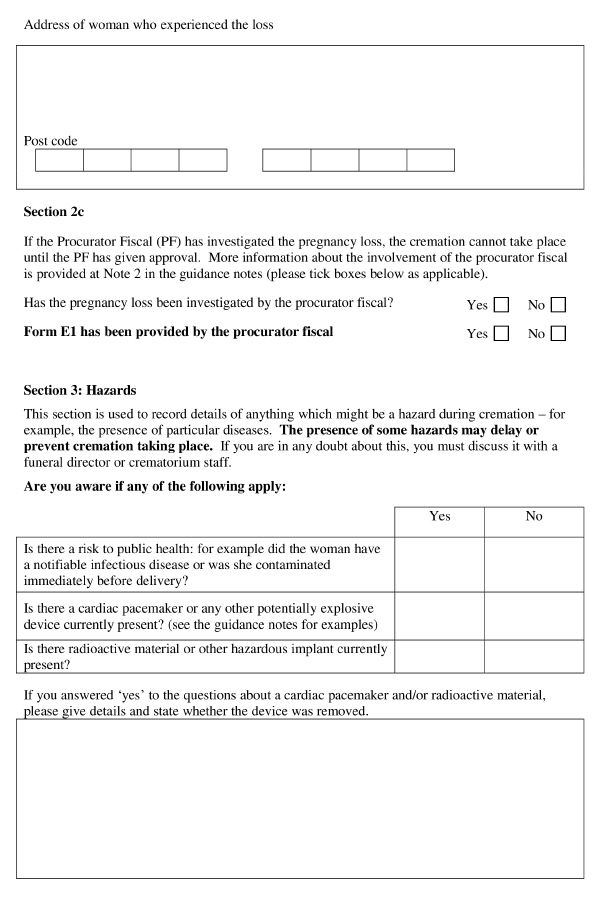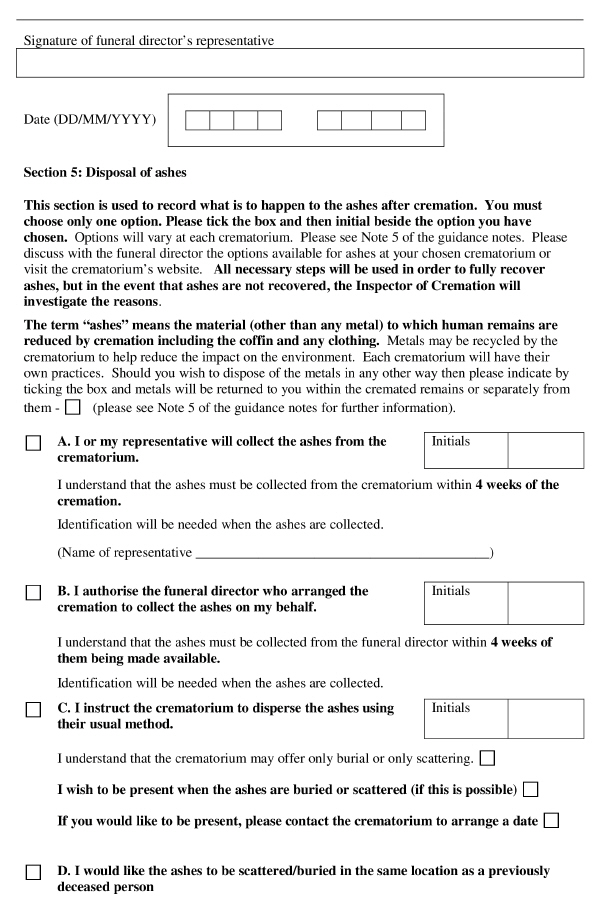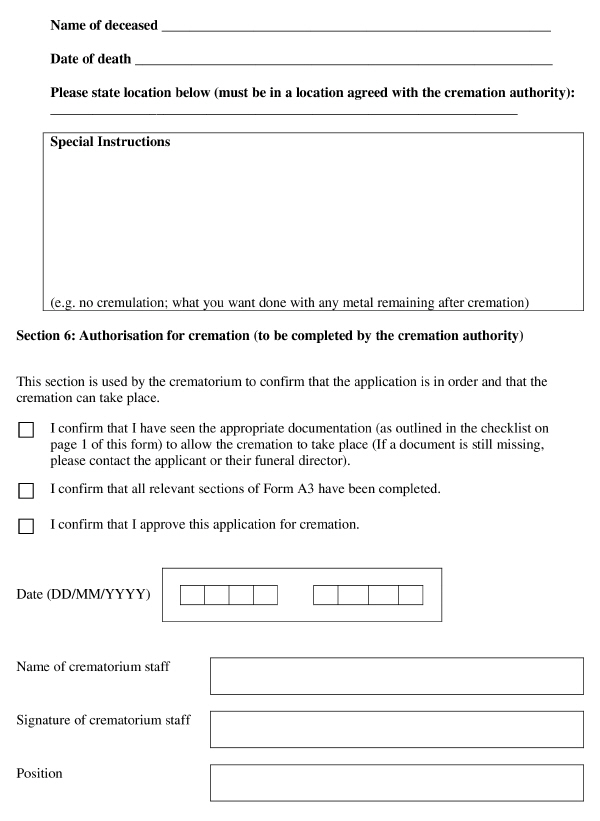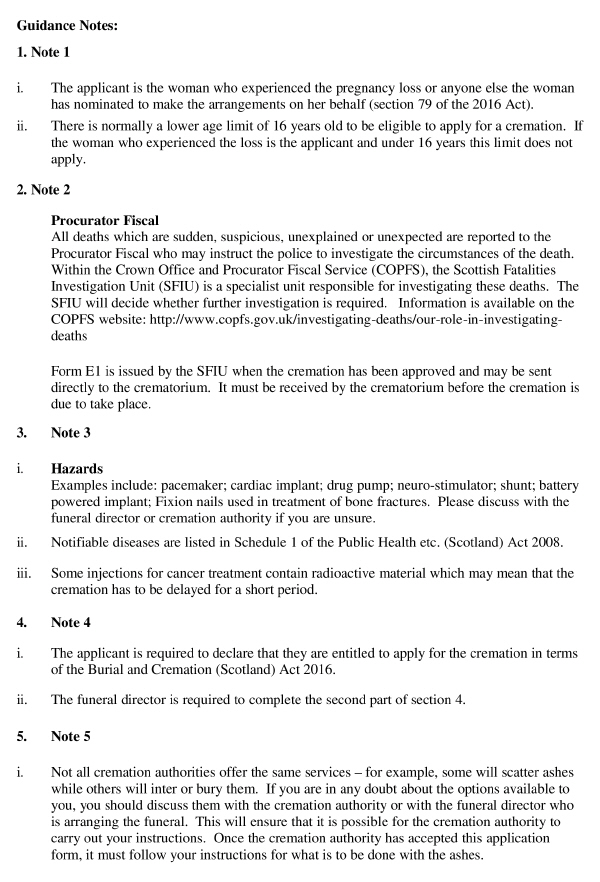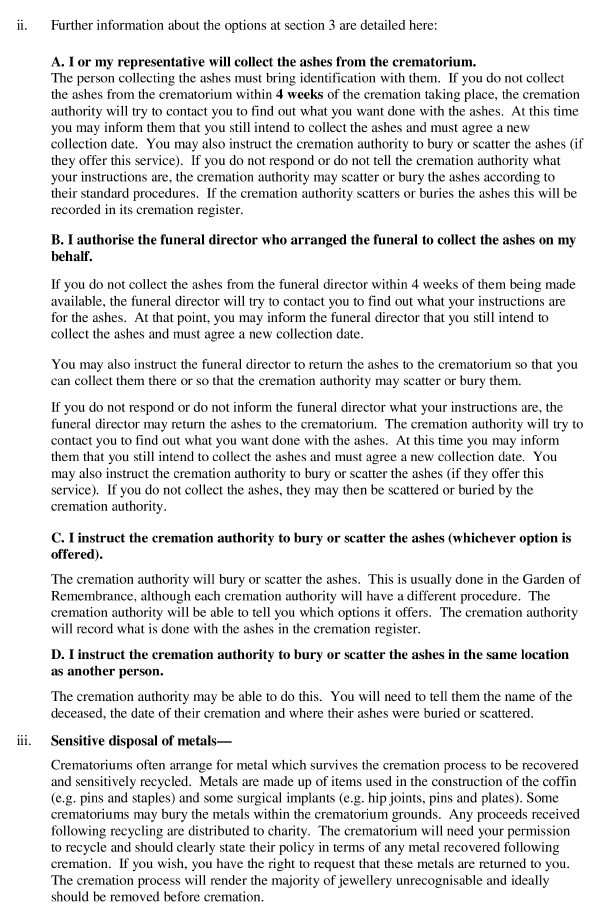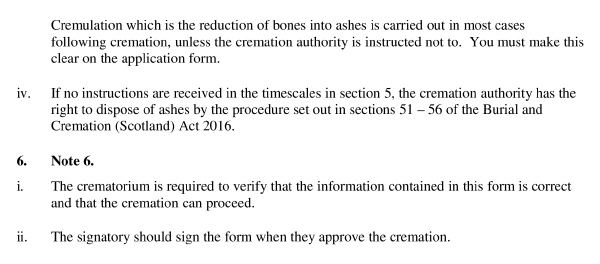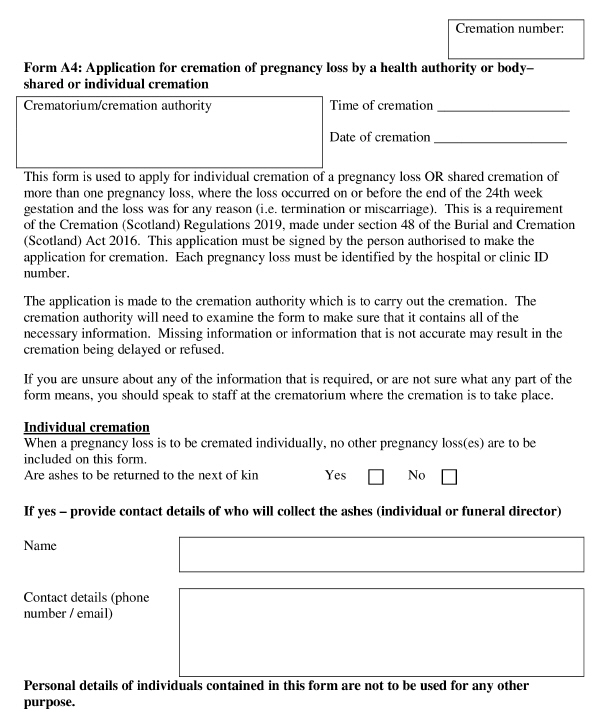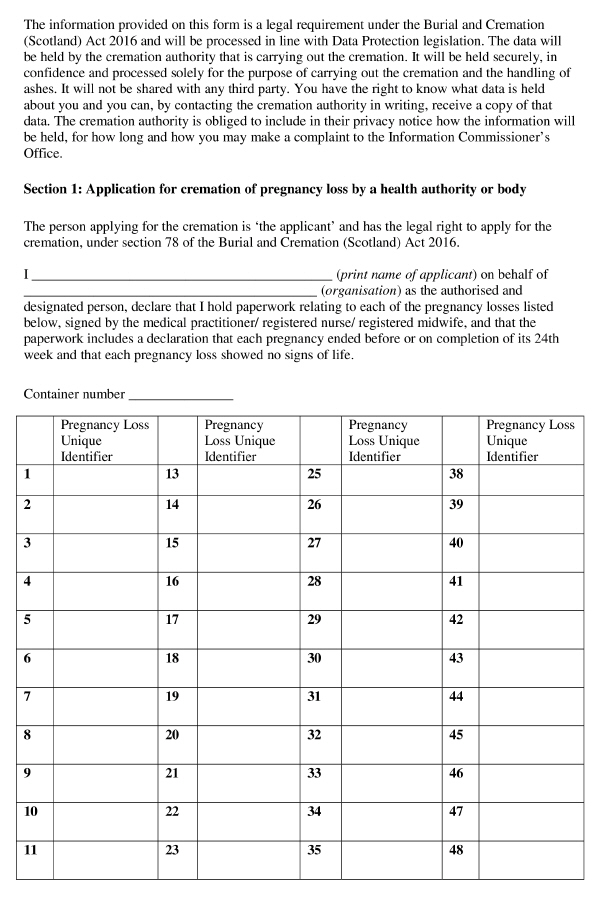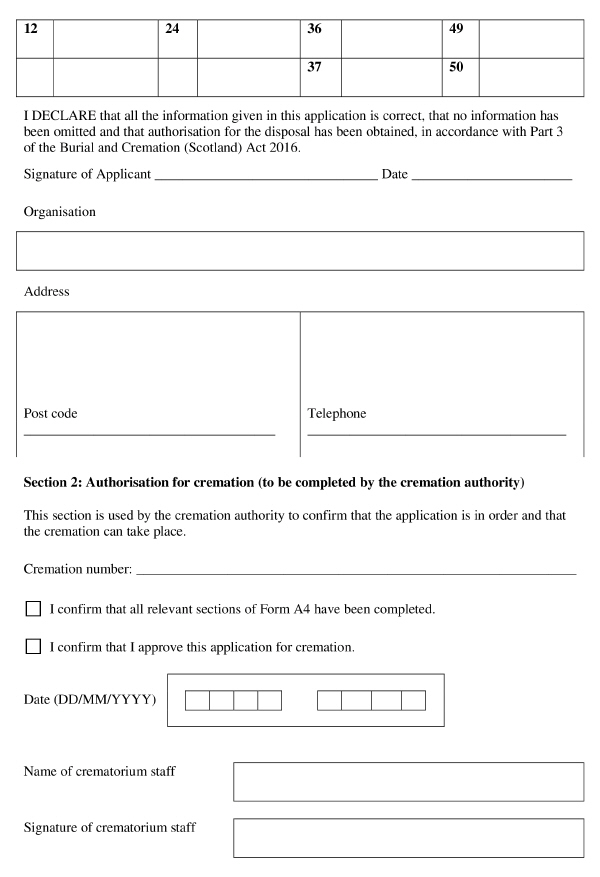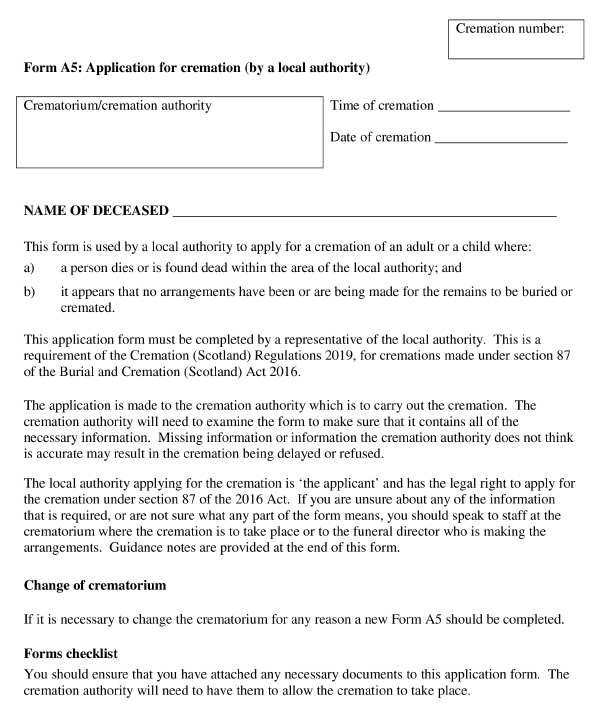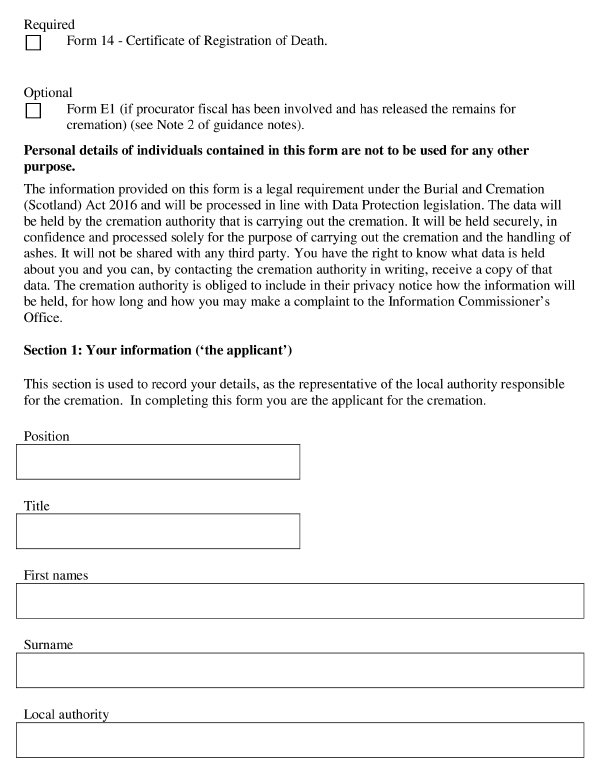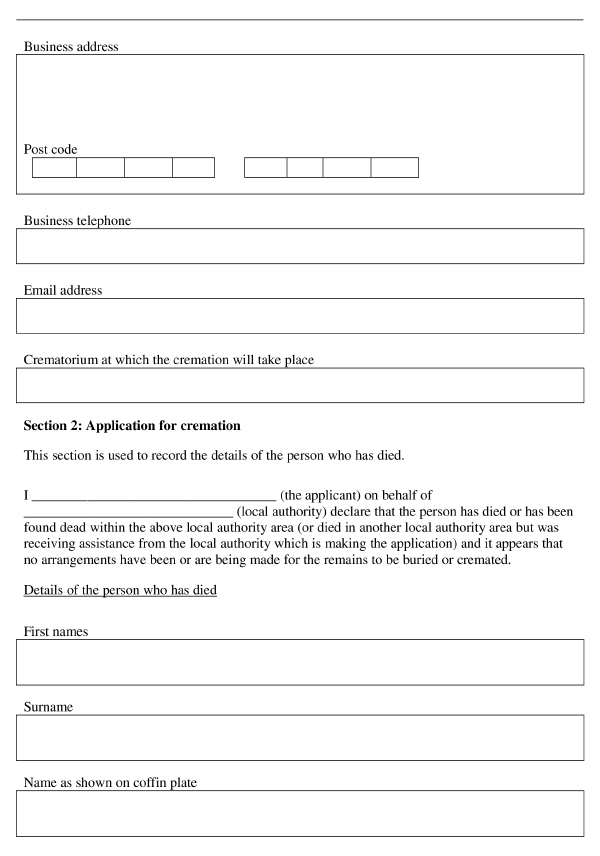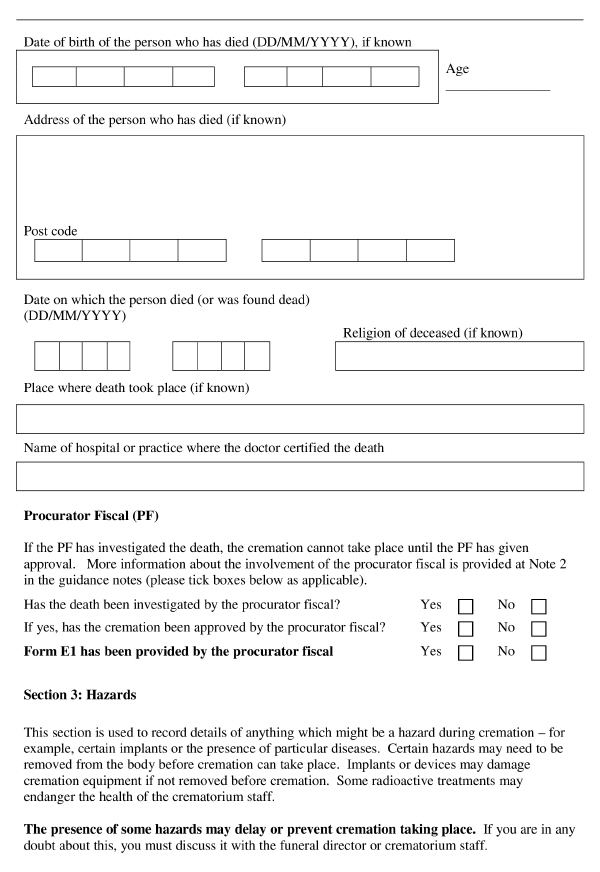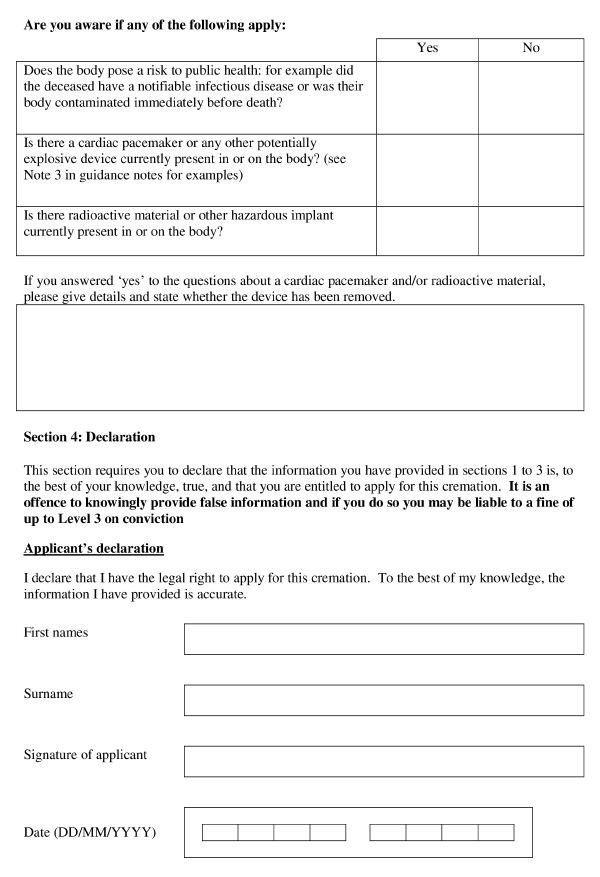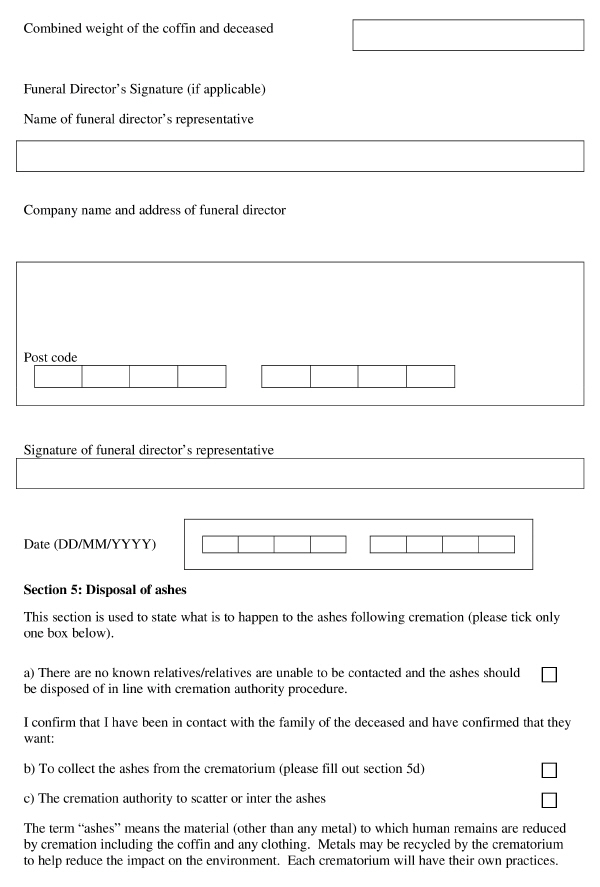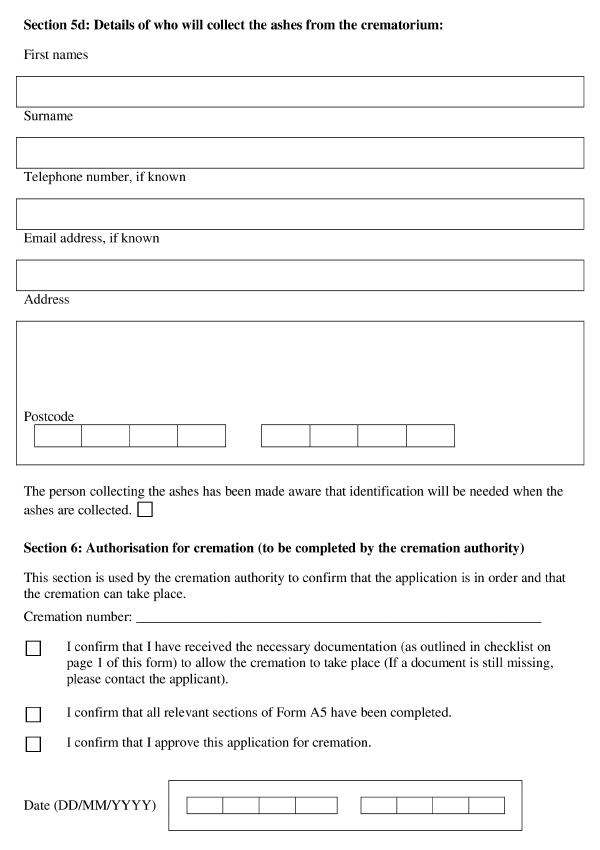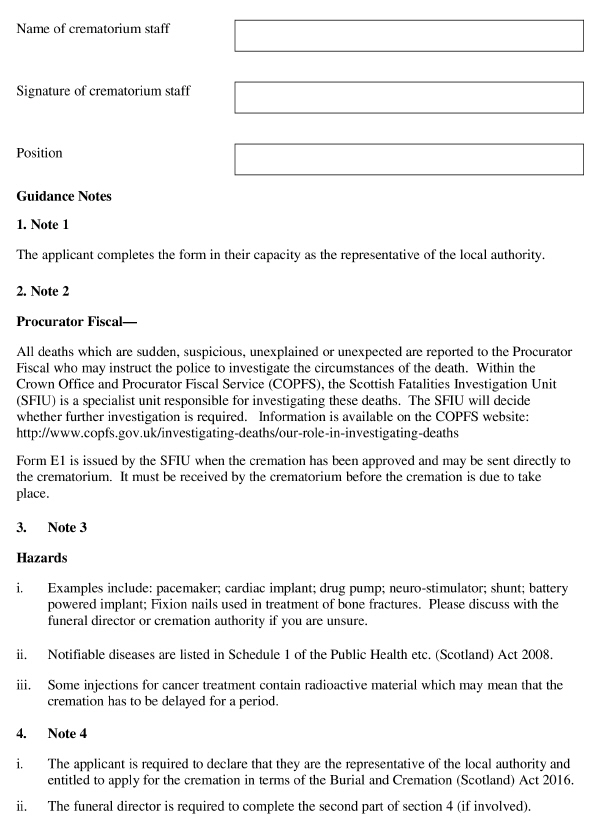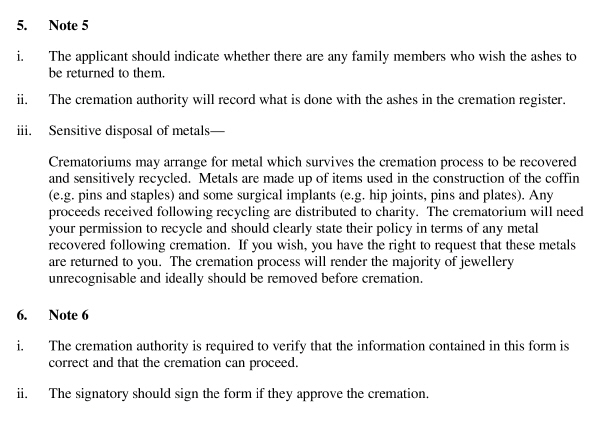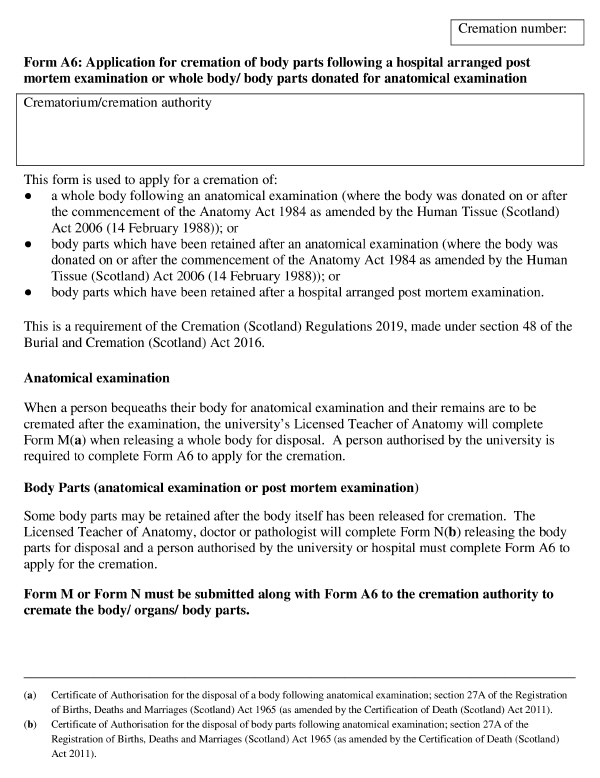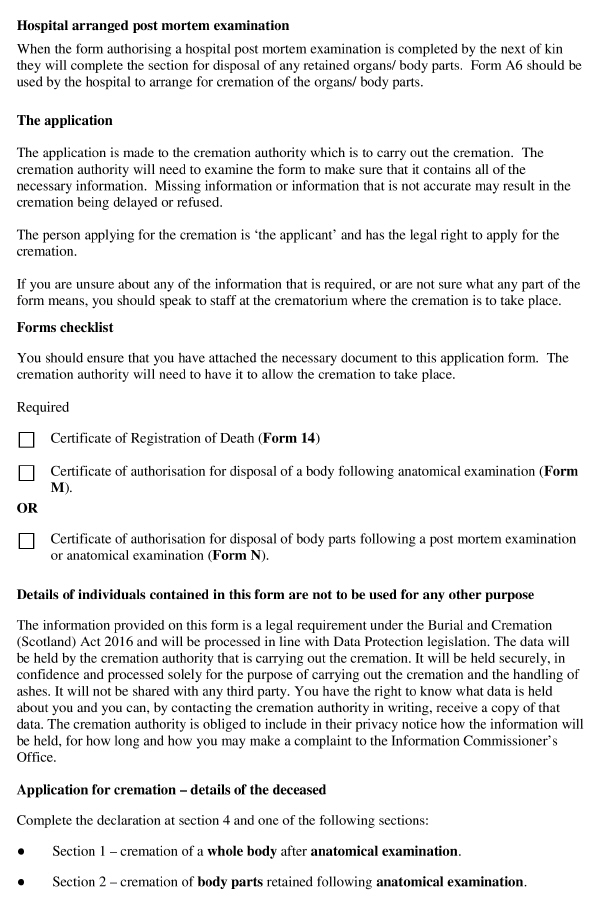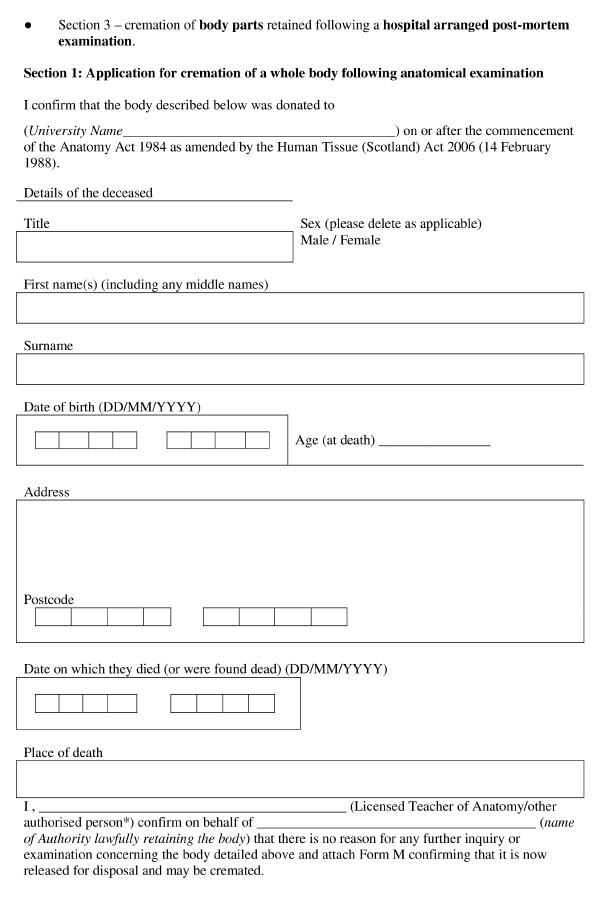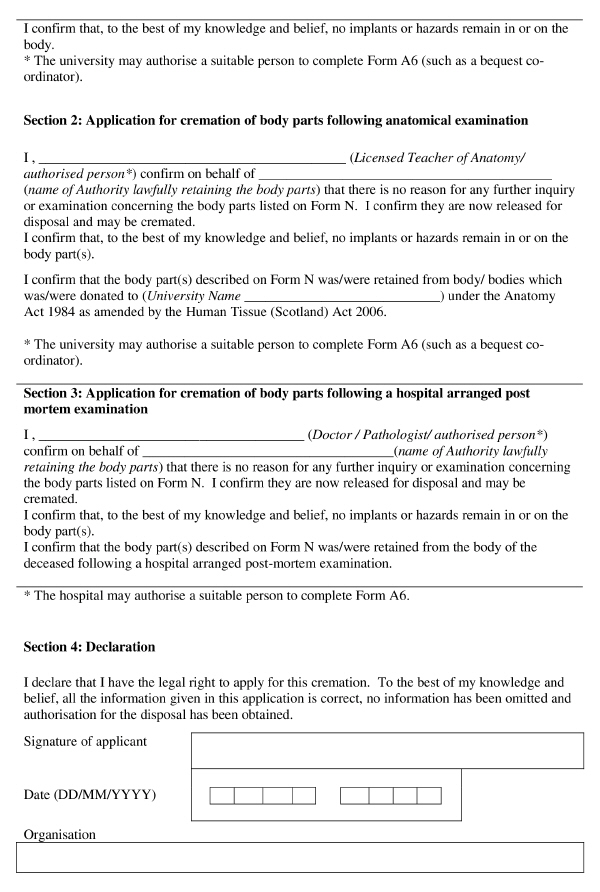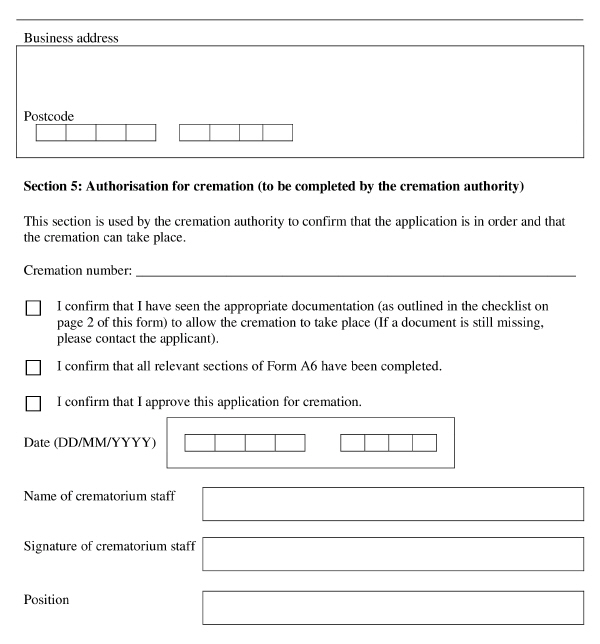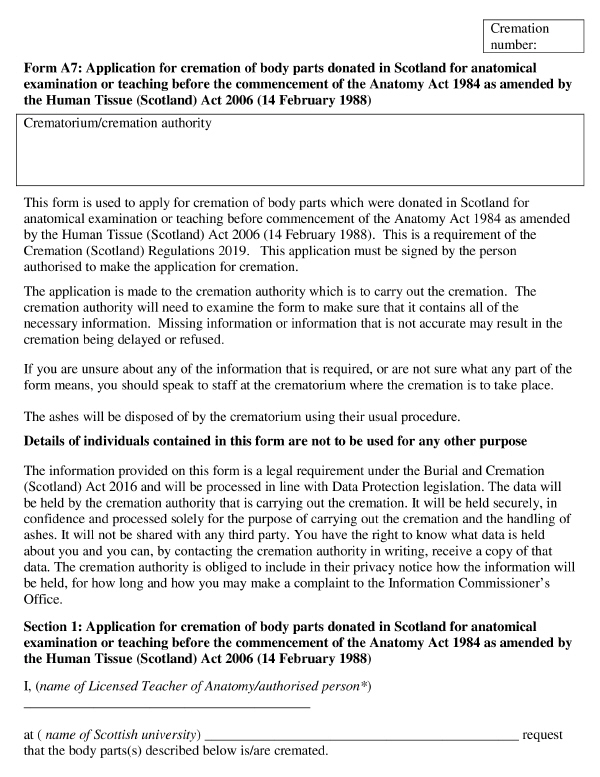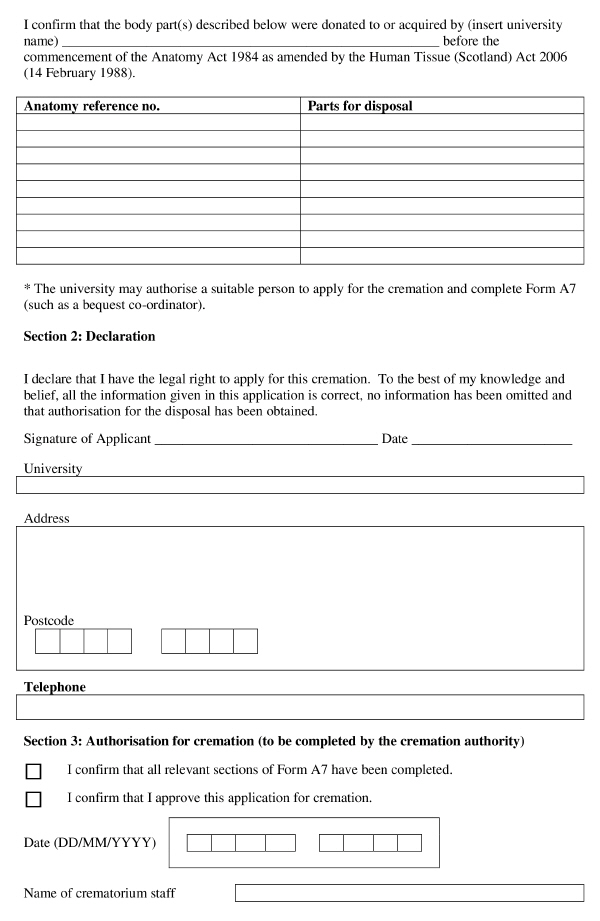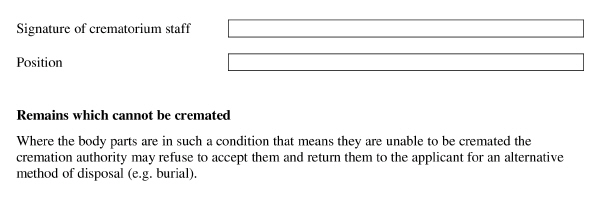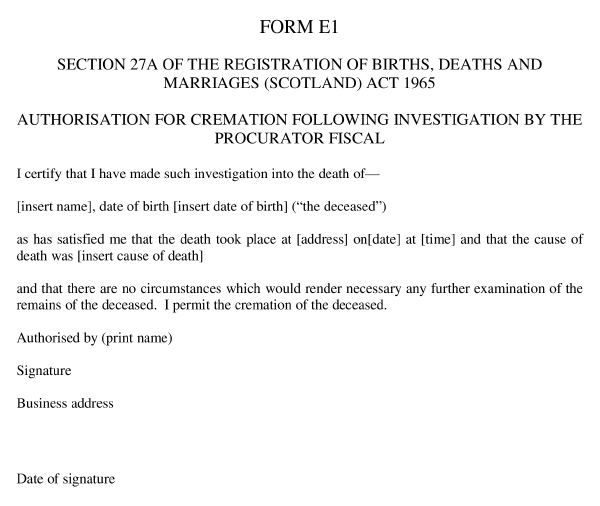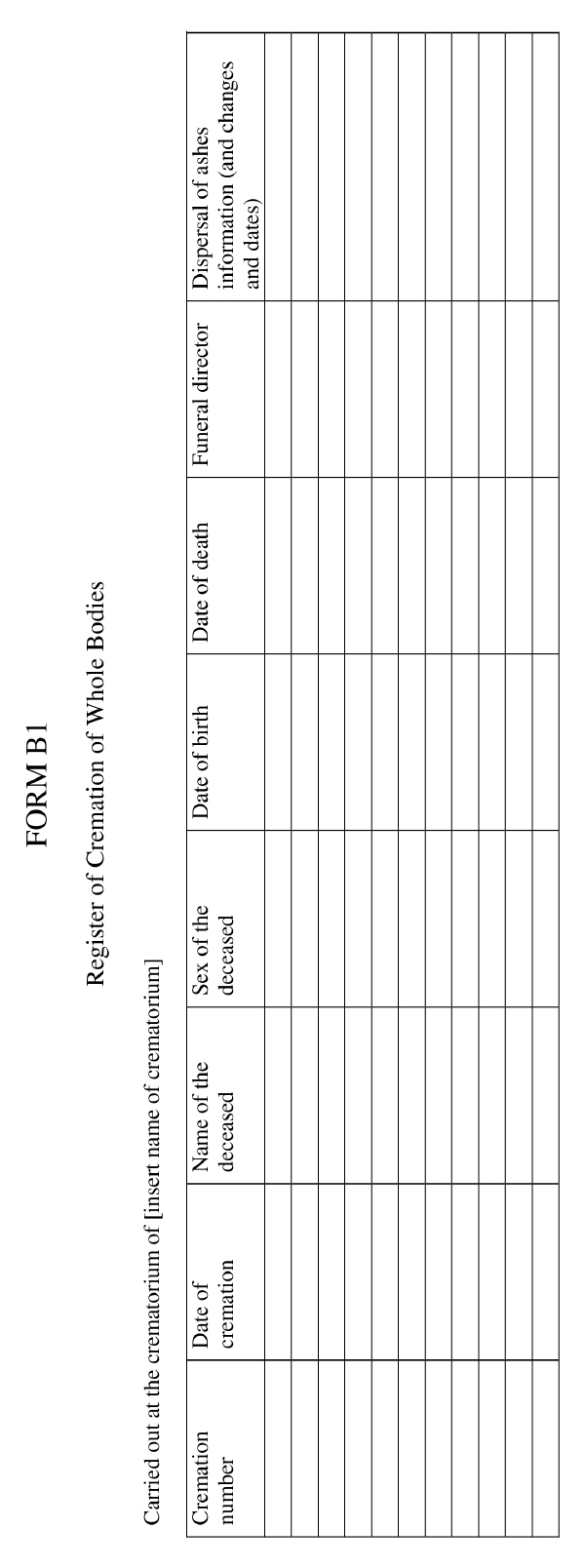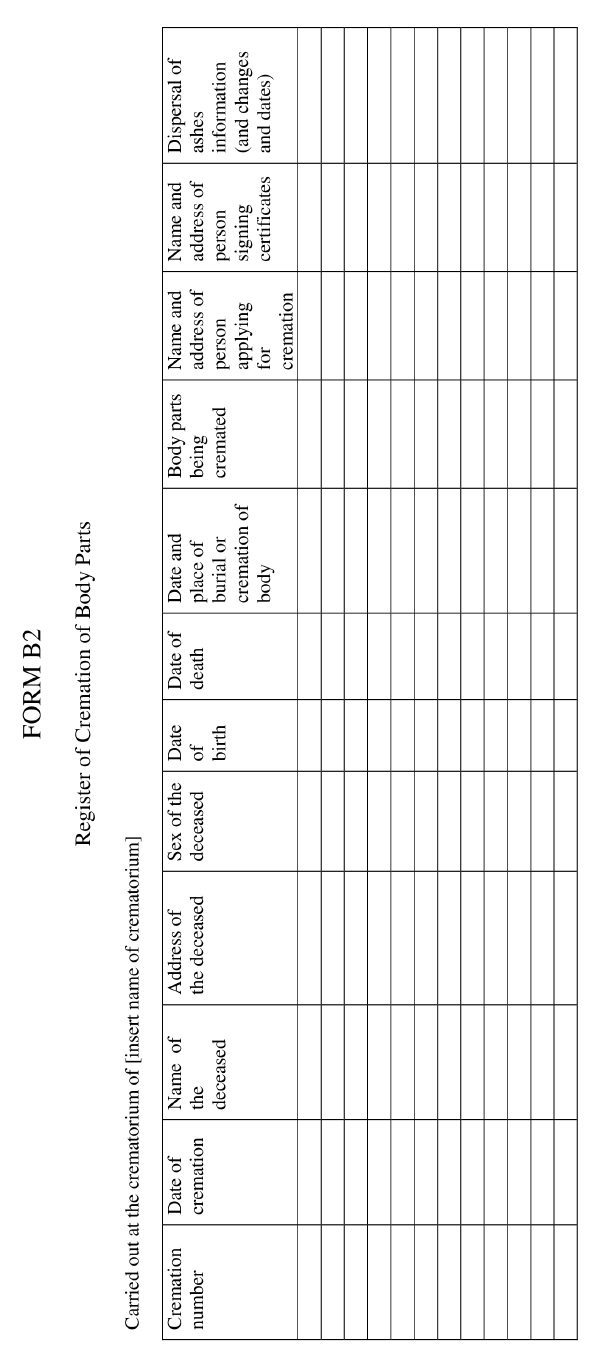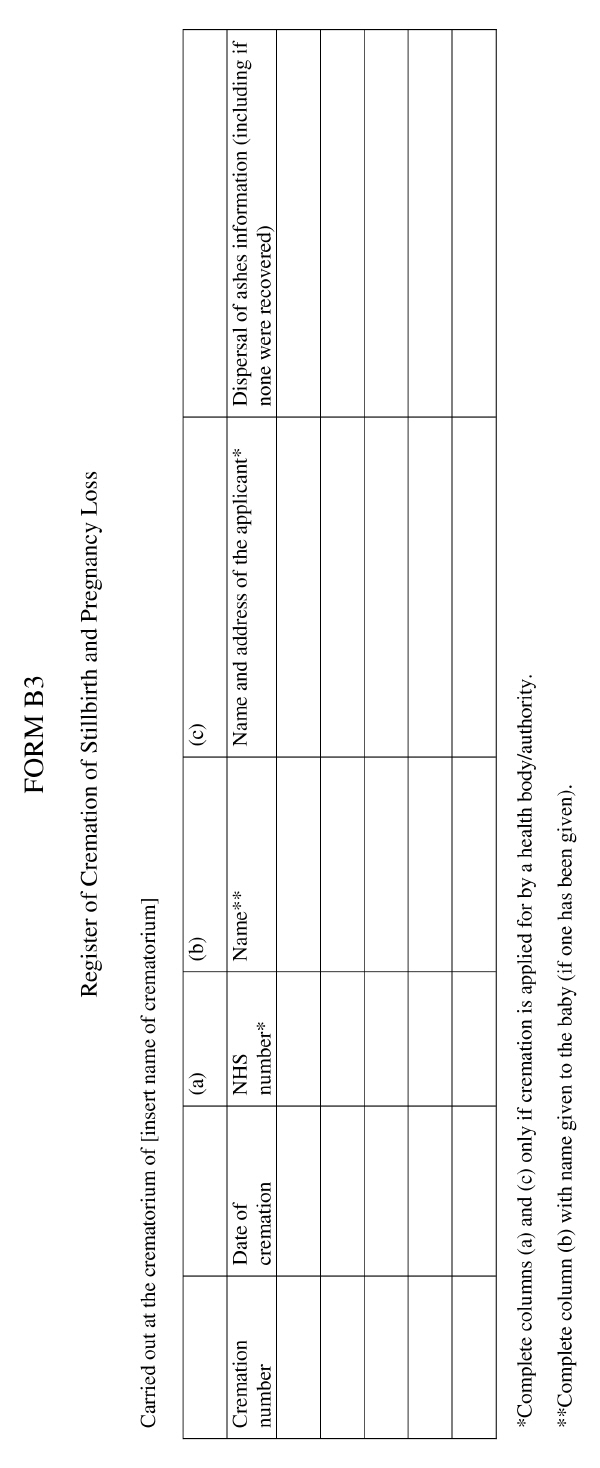- Latest available (Revised)
- Original (As made)
The Cremation (Scotland) Regulations 2019
You are here:
- Scottish Statutory Instruments
- 2019 No. 36
- Whole Instrument
- Previous
- Next
- Show Geographical Extent(e.g. England, Wales, Scotland and Northern Ireland)
- Show Timeline of Changes
More Resources
Changes over time for: The Cremation (Scotland) Regulations 2019
Alternative versions:
Changes to legislation:
There are currently no known outstanding effects for the The Cremation (Scotland) Regulations 2019.![]()
Changes to Legislation
Revised legislation carried on this site may not be fully up to date. At the current time any known changes or effects made by subsequent legislation have been applied to the text of the legislation you are viewing by the editorial team. Please see ‘Frequently Asked Questions’ for details regarding the timescales for which new effects are identified and recorded on this site.
Scottish Statutory Instruments
2019 No. 36
Cremation
The Cremation (Scotland) Regulations 2019
Made
7th February 2019
Coming into force
4th April 2019
The Scottish Ministers make the following Regulations in exercise of the powers conferred by sections 47(1), 48(2) and (4), 56(1) and (2), 57(1) and (2) and 106(1)(a) of the Burial and Cremation (Scotland) Act 2016 M1 and section 27A(2) and (6)(a) of the Registration of Births, Deaths and Marriages (Scotland) Act 1965 M2 and all other powers enabling them to do so.
In accordance with section 104(4) of the Burial and Cremation (Scotland) Act 2016 they have consulted cremation authorities and such other persons as they consider appropriate.
In accordance with section 106(2) of that Act a draft of this instrument has been laid before and approved by resolution of the Scottish Parliament M3.
Marginal Citations
M12016 asp 20 (“the Act”).
M21965 c.49. Section 27A was inserted by the Certification of Death (Scotland) Act 2011 (asp 11), section 25.
M3The powers to make these Regulations are exercised together by virtue of section 33(2) of the Interpretation and Legislative Reform (Scotland) Act 2010 (asp 10). By virtue of that section the Regulations are subject to the affirmative procedure.
GeneralS
Citation, commencement and interpretationS
1.—(1) These Regulations may be cited as the Cremation (Scotland) Regulations 2019 and come into force on 4 April 2019.
(2) In these Regulations—
“the Act” means the Burial and Cremation (Scotland) Act 2016,
“adult” means a person who is 16 years of age or over,
“child” means a person (other than a still-born child) who is under 16 years of age,
“electronic communication” has the meaning given in section 15(1) (general interpretation) of the Electronic Communications Act 2000 M4 and similar expressions are to be construed accordingly,
“joint cremation” has the meaning given in regulation 6(3), and
“” has the meaning given in regulation 7(3).
(3) A form set out in a schedule of these Regulations may be communicated electronically.
(4) A signature required as shown on a form set out in a schedule of these Regulations must, where—
(a)an electronic form is used or a form is an electronic communication, be—
(i)a signature in digital ink, or
(ii)an image of a signature,
(b)a paper form is used, be a signature in ink,
and must be the signatory's handwritten signature.
Commencement Information
I1Reg. 1 in force at 4.4.2019, see reg. 1(1)
Marginal Citations
M42000 c.7. Section 15 was amended by paragraph 158 of schedule 17 of the Communications Act 2003 (c.21).
Management and operation of crematoriumsS
Management of crematoriumsS
2.—(1) Each cremation authority must—
(a)prepare and maintain a Crematorium Management Plan in accordance with paragraph (3) (“the Plan”) in relation to each crematorium for which it is the cremation authority, and
(b)ensure that the crematorium is managed and operated in accordance with the Plan.
(2) A cremation authority must make arrangements for the Plan to be available for inspection by—
(a)a person appointed under section 89(1)(b) (inspectors of cremation) of the Act, and
(b)members of the public.
(3) For the purposes of this regulation a Crematorium Management Plan is a document which is prepared and maintained by the cremation authority with responsibility for the management of the crematorium and which contains provision about the matters specified in paragraph (4).
(4) The matters are—
(a)the name, address and business hours of the crematorium,
(b)procedures for—
(i)the carrying out of cremations,
(ii)dealing with any unexpected increase in the number of cremations,
(iii)the operation, and servicing, of all equipment used in the cremation process,
(iv)the disposal of cremation residues,
(v)the disposal of ashes, and
(vi)contingency arrangements for any unexpected disruption to, or loss of, services,
(c)the review of the Plan.
(5) The Plan must be—
(a)prepared within 6 months from the date these Regulations come into force, and
(b)reviewed at least every 12 months thereafter.
(6) In paragraph (4)(a) “address” includes the email address (if any) of the crematorium.
Commencement Information
I2Reg. 2 in force at 4.4.2019, see reg. 1(1)
RecordsS
3.—(1) For each cremation it carries out each cremation authority must retain for a period of 50 years beginning with the date on which the cremation is carried out the cremation application form submitted in accordance with regulation 8 and any accompanying documentation or certificates.
(2) All documentation retained under paragraph (1) must be treated by the cremation authority as confidential.
(3) The cremation authority must ensure that all documentation retained under paragraph (1) is at all times kept in an accessible form in secure conditions and that all appropriate measures are taken to prevent theft, unauthorised disclosure, damage, loss or destruction.
Commencement Information
I3Reg. 3 in force at 4.4.2019, see reg. 1(1)
Maintenance and operation of crematoriumsS
4.—(1) The cremation authority must, in respect of each crematorium for which it is the cremation authority, ensure—
(a)the equipment installed at each crematorium is maintained—
(i)in efficient working order,
(ii)in good repair, and
(iii)in a clean and orderly condition,
(b)staff are trained in the operation of the equipment installed at the crematorium, and
(c)the equipment is regularly serviced.
(2) The cremation authority must prepare and maintain a written record of—
(a)all training undertaken by staff operating at the crematorium, and
(b)each service check carried out in accordance with paragraph (1)(c).
Commencement Information
I4Reg. 4 in force at 4.4.2019, see reg. 1(1)
Operation of crematorS
5.—(1) This regulation applies where a cremation is carried out.
(2) A cremation authority must ensure that—
(a)the remains of only one adult, child, still-born child or fetus are placed in the cremator, and
(b)at the end of the burning process the remains are raked into the cooling tray before the remains of another adult, child, still born child or fetus are placed in the cremator for cremation.
(3) Paragraph (2)(a) does not apply to—
(a)a joint cremation, or
(b)a shared cremation.
Commencement Information
I5Reg. 5 in force at 4.4.2019, see reg. 1(1)
Joint cremationsS
6.—(1) Where paragraph (2) applies a cremation authority may—
(a)cremate together the remains of two adults,
(b)cremate the remains of one adult together with one, or more than one, child, still-born child or fetus, or
(c)cremate together the remains of more than one child, still-born child or fetus.
(2) This paragraph applies where, in the circumstances described in—
(a)paragraph (1)(a), written permission has been given by the authorised person for the cremation together of each adult,
(b)paragraph (1)(b), written permission has been given by the authorised person for the cremation together of the adult and each child, still-born child or fetus, or
(c)paragraph (1)(c), written permission has been given by the authorised person for the cremation together of each child, still-born child or fetus.
(3) A cremation carried out in accordance with this regulation is to be known as a joint cremation.
(4) In paragraph (2) “the authorised person” is—
(a)for an adult, a person who may submit an application for cremation in respect of the adult by virtue of regulation 8(2)(a),
(b)for a child, a person who may submit an application for cremation in respect of the child by virtue of regulation 8(2)(b),
(c)for a still-born child or fetus, a person who may submit an application for cremation in respect of the still-born child or fetus by virtue of regulation 8(2)(c).
Commencement Information
I6Reg. 6 in force at 4.4.2019, see reg. 1(1)
Shared cremationsS
7.—(1) Where paragraph (2) applies a cremation authority may cremate together the remains of more than one fetus.
(2) This paragraph applies where—
(a)an application is made under regulation 8(3)(d) in the form set out in schedule 4 for the cremation together of the remains of more than one fetus, and
(b)the application is made by the health body or authority which is authorised to make arrangements for the cremation of each fetus by virtue of section 77(2)(c), 79(2)(c), 80(2), 81(2) or 84(2) of the Act.
(3) A cremation carried out in accordance with this regulation is to be known as a shared cremation.
Commencement Information
I7Reg. 7 in force at 4.4.2019, see reg. 1(1)
Cremation applicationsS
Application for cremationS
8.—(1) An application under section 48(1) of the Act (application for cremation) is to be made in accordance with this regulation.
(2) An application for cremation may be submitted where—
(a)the deceased is an adult by—
(i)the person specified by the adult in an arrangements on death declaration M5 made by the adult,
(ii)any person who may make arrangements on the death of the adult by virtue of section 65(2), 68 or 87 of the Act,
(iii)a person employed in the provision of, or managing the provision of, a care home service at which the deceased was living at the time of his or her death, or
(iv)the managers of the hospital in which the deceased died or any officer or person designated for that purpose by the managers,
(b)the deceased is a child, by a person who may make arrangements on the death of the child by virtue of section 66(2), 68 or 87 of the Act,
(c)the remains to be cremated are those of a still-born child or fetus, by the mother, or the person with authority to make arrangements in relation to the remains of that still-born child or fetus by virtue of Part 3 of the Act, or
(d)the body or any body part or body parts of the deceased have undergone anatomical examination, by a person licensed under section 3(2) of the Anatomy Act 1984 M6.
(3) An application for—
(a)the cremation of an adult or child (other than an application made by a local authority) must be in the form set out in schedule 1 and contain the information and documents specified in sections 1 to 4 of that form,
(b)the cremation of a still-born child must be in the form set out in schedule 2 and contain the information and documents specified in sections 1 to 4 of that form,
(c)the cremation of a fetus where an individual is making arrangements for the cremation of the fetus, must be in the form set out in schedule 3 and contain the information and documents specified in sections 1 to 4, of that form,
(d)the cremation of a fetus where a person other than an individual is making arrangements for the cremation under Part 3 of the Act must be in the form set out in schedule 4 and contain the information and documents specified in section 1 of that form,
(e)the cremation of an adult or child made by a local authority by virtue of section 87 of the Act (burial or cremation: duty of local authority) must be in the form set out in schedule 5 and contain the information and documents specified in sections 1 to 4 of that form,
(f)the cremation of a body part or parts following a post-mortem examination (other than a post-mortem examination carried out for the purposes of the functions, or under the authority, of the procurator fiscal) must be in the form set out in schedule 6 and contain the information and documents specified in section 3 that form,
(g)the cremation of a body, body part or body parts following anatomical examination where authority was given under—
(i)section 4A(1), or
(ii)section 4(2),
of the Anatomy Act 1984 for the person's body to be used for anatomical examination must be in the form set out in schedule 6 and contain the information and documents specified for the cremation of a whole body, in section 1 of that form or, for the cremation of a body part or body parts, in section 2 of that form,
(h)the cremation of a body part or parts following anatomical examination where the deceased died before 14th February 1988 must be in the form set out in schedule 7 and contain the information specified in section 1 of that form.
(4) In paragraph (2)(a)(iii) “care home service” means a care home service within the meaning of paragraph 2 of schedule 12 of the Public Services Reform (Scotland) Act 2010 M7.
(5) In paragraph (2)(a)(iv) “managers” in relation to a hospital means—
(a)in relation to a hospital vested in the Scottish Ministers under the National Health Service (Scotland) Act 1978 M8 (“the 1978 Act”) the Health Board, or Special Health Board, responsible for the administration of that hospital,
(b)in the case of a hospital vested in a National Health Service trust established under section 12A of the 1978 M9 Act the directors of the trust,
(c)in the case of an independent health care service which is registered under section 10Q(1) of the 1978 Act the person identified under section 10P(2)(b) M10 of that Act in the application for registration, and
(d)in the case of a state hospital—
(i)where the Scottish Ministers have delegated the management of the hospital to a Health Board, Special Health Board, National Health Service or the Common Services Agency for the Scottish Health Service, that Board, trust or agency,
(ii)where the management of the hospital has not been so delegated, the Scottish Ministers.
Commencement Information
I8Reg. 8 in force at 4.4.2019, see reg. 1(1)
Marginal Citations
M5An “arrangements on death declaration” is defined in section 65(8) of the Burial and Cremation (Scotland) Act 2016 asp 20.
M9Section 12A was inserted by the National Health Service and Community Care Act 1990 (c.19), section 31
M10Sections 10Q and 10P were inserted by the Public Services Reform (Scotland) Act 2010 (asp 8), section 108.
Deaths investigated by the procurator fiscal: requirements for cremationS
9. Where the death of a person has been investigated by the procurator fiscal a certificate in the form of Form E1 set out in schedule 8 confirming that the remains of the deceased may be cremated is specified for the purpose of section 27A(2)(a) of the Registration of Births, Deaths and Marriages (Scotland) Act 1965 M11 for the disposal of the remains of that person by cremation.
Cremation following warrant to disinterS
10.—(1) This regulation applies where—
(a)a cremation authority receives an application for cremation under regulation 8, and
(b)the person who submits the application referred to in sub-paragraph (a) informs the cremation authority that a warrant to disinter has been granted by the sheriff in respect of the remains of the deceased specified on the application form.
(2) The cremation authority may only carry out the cremation after the warrant to disinter has been received by the cremation authority.
Commencement Information
I10Reg. 10 in force at 4.4.2019, see reg. 1(1)
Cremation applications: further inquiryS
11. A cremation authority may make any inquiry in respect of an application made under regulation 8 and any accompanying documentation, evidence or certificates.
Commencement Information
I11Reg. 11 in force at 4.4.2019, see reg. 1(1)
Handling of ashesS
Handling of ashes: noticesS
12.—(1) Where, by virtue of section 52(3) (duty of cremation authority following cremation) of the Act, a funeral director has collected ashes from a cremation authority, the funeral director must as soon as reasonably practicable after collecting the ashes from the cremation authority give written notice to the applicant that the ashes are available for collection by the applicant from the funeral director.
(2) Paragraph (3) applies where, by virtue of section 54(5) (power of funeral director in relation to ashes) of the Act, a funeral director returns ashes to a cremation authority.
(3) For the purpose of section 55(2) (duties of cremation authority where ashes returned) of the Act the cremation authority must as soon as reasonably practicable after the ashes are returned to the cremation authority by the funeral director give written notice to the applicant to ascertain whether the applicant wishes—
(a)the ashes to be retained by the cremation authority during the specified period and made available for collection during that period by the applicant, or
(b)the ashes to be disposed of by the cremation authority in the specified manner.
(4) In this regulation—
“applicant” has the meaning given by section 52(5) of the Act,
“specified” has the meaning given by section 51(4) of the Act M12.
(5) In this regulation reference to a written notice includes an electronic communication.
Commencement Information
I12Reg. 12 in force at 4.4.2019, see reg. 1(1)
Marginal Citations
M12Regulation 13(4) makes provision for the specified period for the purpose of section 55(2)(a) and (3) of the Act. Regulation 14 makes provision for the specified manner of disposal of ashes for the purpose of section 55 (and sections 51 and 53) of the Act.
Handling of ashes: time periods for collection of ashes (specified period)S
13.—(1) For the purposes of sections 51(3)(a) and (b) (duty of cremation authority before carrying out cremation) and 52(2) and (3) (duty of cremation authority following cremation) of the Act the specified period during which ashes are to be retained by the cremation authority and made available for collection is 4 weeks beginning with the day after the day on which the cremation took place.
(2) For the purposes of section 53(2)(a) and (b) (failure to collect ashes) of the Act the further period is 4 weeks beginning with the day after the end of the specified period mentioned in paragraph (1).
(3) For the purposes of section 54(1)(b) (power of funeral director in relation to ashes) of the Act the specified period for the applicant to collect the ashes from the funeral director is 4 weeks beginning with the day written notice is given to the applicant by the funeral director under regulation 12(1).
(4) For the purposes of section 55(2)(a) and (3) (duties of cremation authority where ashes returned) of the Act the specified period during which ashes are to be retained by the cremation authority and made available for collection is 4 weeks beginning with the day written notice is given to the applicant by the cremation authority under regulation 12(3).
(5) In this regulation “applicant” has the meaning given by section 52(5) of the Act.
Modifications etc. (not altering text)
C1Reg. 13(2)(3)(4): power to suspend conferred (temp.) (25.3.2020) by Coronavirus Act 2020 (c. 7), s. 87(1), Sch. 14 para. 9 (with ss. 88-90) (which affecting provision expires (25.3.2022) by virtue of Coronavirus Act 2020 (c. 7), s. 89 (with s. 90))
C2Reg. 13(2)(3)(4) expiry of earlier affecting provision 2020 c. 7, Sch. 14 (25.3.2022) by Coronavirus Act 2020 (c. 7), s. 89 (with s. 90)
Commencement Information
I13Reg. 13 in force at 4.4.2019, see reg. 1(1)
Disposal of ashes by cremation authority (specified manner)S
14. For the purposes of section 51(3)(c) (disposal of ashes by cremation authority), 53(6)(b) (failure to collect ashes) and 55(2)(b), (4) and (5)(b) (duties of cremation authorities where ashes returned) of the Act the specified manner for the disposal of ashes by the cremation authority is the burial or scattering of the ashes by the cremation authority.
Commencement Information
I14Reg. 14 in force at 4.4.2019, see reg. 1(1)
Cremation registerS
Cremation registerS
15.—(1) For the purpose of section 57(1) of the Act a cremation register must—
(a)for the cremation of an adult or child, be in the form set out in schedule 9 and contain the information specified in that form,
(b)for the cremation of a body part, or body parts, be in the form set out in schedule 10 and contain the information specified in that form, and
(c)for the cremation of a fetus or still-born child, be in the form set out in schedule 11 and contain the information specified in that form.
(2) The information in respect of each cremation must be entered on the register as soon as practicable after the cremation.
(3) The cremation authority must—
(a)review each register from time to time, and
(b)ensure that the information in each register is accurate and up to date.
Commencement Information
I15Reg. 15 in force at 4.4.2019, see reg. 1(1)
JOE FITZPATRICK
Authorised to sign by the Scottish Ministers
St Andrew's House,
Edinburgh
Regulation 8(3)(a)
SCHEDULE 1SAPPLICATION FORM FOR THE CREMATION OF ADULT OR CHILD
Commencement Information
I16Sch. 1 in force at 4.4.2019, see reg. 1(1)
Regulation 8(3)(b)
SCHEDULE 2SAPPLICATION FORM FOR THE CREMATION OF A STILLBORN BABY
Commencement Information
I17Sch. 2 in force at 4.4.2019, see reg. 1(1)
Regulation 8(3)(c)
SCHEDULE 3SAPPLICATION FORM FOR THE CREMATION OF A PREGNANCY LOSS ON OR BEFORE 24 WEEKS
Commencement Information
I18Sch. 3 in force at 4.4.2019, see reg. 1(1)
Regulation 8(3)(d)
SCHEDULE 4SAPPLICATION FORM FOR THE CREMATION OF A PREGNANCY LOSS ON OR BEFORE 24 WEEKS: HEALTH AUTHORITY OR BODY ARRANGED CREMATION
Commencement Information
I19Sch. 4 in force at 4.4.2019, see reg. 1(1)
Regulation 8(3)(e)
SCHEDULE 5SAPPLICATION FORM FOR THE CREMATION OF AN ADULT OR CHILD: LOCAL AUTHORITY APPLICATION UNDER SECTION 87
Commencement Information
I20Sch. 5 in force at 4.4.2019, see reg. 1(1)
Regulation 8(3)(f) and (g)
SCHEDULE 6SAPPLICATION FORM FOR THE CREMATION OF BODY PARTS FOLLOWING POST-MORTEM EXAMINATION OR A WHOLE BODY OR BODY PARTS FOLLOWING ANATOMICAL EXAMINATION
Commencement Information
I21Sch. 6 in force at 4.4.2019, see reg. 1(1)
Regulation 8(3)(h)
SCHEDULE 7SAPPLICATION FORM FOR THE CREMATION OF BODY PARTS FOLLOWING ANATOMICAL EXAMINATION WHERE THE DECEASED DIED BEFORE 14 FEBRUARY 1988
Commencement Information
I22Sch. 7 in force at 4.4.2019, see reg. 1(1)
Regulation 9
SCHEDULE 8SDEATH INVESTIGATED BY PROCURATOR FISCAL – FORM E1
Commencement Information
I23Sch. 8 in force at 4.4.2019, see reg. 1(1)
S
Regulation 15(1)(a)
SCHEDULE 9SCREMATION REGISTER – WHOLE BODIES
Commencement Information
I24Sch. 9 in force at 4.4.2019, see reg. 1(1)
S
Regulation 15(1)(b)
SCHEDULE 10SCREMATION REGISTER – BODY PARTS
Commencement Information
I25Sch. 10 in force at 4.4.2019, see reg. 1(1)
S
Regulation 15(1)(c)
SCHEDULE 11SCREMATION REGISTER – STILLBIRTH AND PREGNANCY LOSS
Commencement Information
I26Sch. 11 in force at 4.4.2019, see reg. 1(1)
S
Explanatory Note
(This note is not part of the Regulations)
These Regulations make provision regarding cremations in Scotland, in particular in respect of the management and operation of crematoriums, applications for cremation, the handling of ashes and cremation registers. The Burial and Cremation (Scotland) Act 2016 (“the Act”) repeals and replaces the Cremation Acts 1902 and 1952 as they apply to Scotland. The Act makes provision to regulate cremation and places duties on cremation authorities.
Regulations 2 to 4 concern the operation and management of crematoriums. Regulation 2 provides that cremation authorities must prepare and maintain a management plan to be known as a Crematorium Management Plan which must make provision about matters specified in regulation 2(4). The Plan must be regularly reviewed and available for inspection by members of the public or an inspector of cremation. Regulation 3 makes provision about documentation which must be retained by the authorities for a period of 50 years on a confidential basis. A person appointed as an inspector of cremation will have powers to enter premises to investigate compliance with these Regulations and provisions under the Act. Regulation 4 makes provision imposing duties on cremation authorities in connection with maintenance and operation of crematoriums.
Regulations 5 to 7 make provision regarding the operation of cremators. Cremation authorities must ensure that cremations are not combined to ensure the remains of only one adult, child, still-born child or fetus are cremated each time (regulation 5). This does not apply to a joint cremation or a shared cremation as defined in regulations 6 and 7. A joint cremation is the cremation of the remains of one adult together with one, or more than one, child, still-born child or fetus; or the cremation of the remains of more than one child, still-born child or fetus and may only be carried out with the written permission of each person who has authority to make arrangements for the cremation. A shared cremation is the cremation of the remains of more than one fetus following an application by a health authority or body which is authorised to make arrangements for cremation by virtue of Part 3 of the Act.
Regulations 8 to 11 concern the application process for cremations. Applications must be in a prescribed form and contain the information specified in the relevant form (regulation 8 and schedules 1 to 7). Regulation 9 and schedule 8 and regulation 10 make provision for circumstances where additional documentation is required (authority from the procurator fiscal where the death has been investigated by the fiscal and a warrant to disinter for exhumed remains). Regulation 11 provides that cremation authorities may make inquiries in relation to any application or accompanying documents.
Sections 51 to 56 of the Act make provision about the handling of ashes by cremation authorities and funeral directors, including arrangements for retention, collection and disposal of ashes.
The duties regarding the retention of ashes are set out in sections 52 to 55 of the Act. Where by virtue of section 52(3) of the Act a funeral director has collected ashes from a cremation authority regulation 12(1) makes provision about notice to be given by the funeral director to the applicant. Where by virtue of section 54(5) of the Act a funeral director returns ashes to a cremation authority regulation 12(3) makes provision about notice to be given by the cremation authority to the applicant. Section 26 (service of documents) of the Interpretation and Legislative Reform (Scotland) Act 2010 (asp 10) applies in relation to notices to be given under regulation 12. Regulation 13(1) specifies 4 weeks beginning with the day after the day on which cremation took place, for the purposes of sections 51(3)(a) and (b) and 52(2) and (3) (initial period for retention of ashes by the cremation authority). Where the ashes are not collected, the cremation authority must ascertain whether the applicant wishes the ashes to be retained for a further period: regulation 12(2) specifies 4 weeks beginning with the day after the end of the specified period mentioned in regulation 13(1) as the further period for retention, for the purposes of section 53(2)(a) and (b). Regulation 13(3) specifies 4 weeks beginning with the day notice is given to the applicant under regulation 12(1) for the purpose of section 54(1)(b) (period for collection of ashes from funeral director by the applicant). Regulation 13(4) specifies 4 weeks beginning with the day on which the cremation authority has given notice to the applicant under regulation 12(3) for the purposes of section 55(2)(a) and (3) (period for collection of ashes from cremation authority following return by funeral director).
For the purposes of sections 51, 53 and 55 of the Act regulation 14 provides that the specified method of disposal of ashes is burial or scattering.
Regulation 15 prescribes the form of, and the information which must be recorded in, cremation registers and places a duty on cremation authorities to review each register and ensure that the information is accurate and up to date.
Options/Help
Print Options
PrintThe Whole Instrument
Legislation is available in different versions:
Latest Available (revised):The latest available updated version of the legislation incorporating changes made by subsequent legislation and applied by our editorial team. Changes we have not yet applied to the text, can be found in the ‘Changes to Legislation’ area.
Original (As Enacted or Made): The original version of the legislation as it stood when it was enacted or made. No changes have been applied to the text.
See additional information alongside the content
Geographical Extent: Indicates the geographical area that this provision applies to. For further information see ‘Frequently Asked Questions’.
Show Timeline of Changes: See how this legislation has or could change over time. Turning this feature on will show extra navigation options to go to these specific points in time. Return to the latest available version by using the controls above in the What Version box.
Policy Note
Policy Note sets out a brief statement of the purpose of a Scottish Statutory Instrument and provides information about its policy objective and policy implications. They aim to make the Scottish Statutory Instrument accessible to readers who are not legally qualified and accompany any Scottish Statutory Instrument or Draft Scottish Statutory Instrument laid before the Scottish Parliament from July 2012 onwards. Prior to this date these type of notes existed as ‘Executive Notes’ and accompanied Scottish Statutory Instruments from July 2005 until July 2012.
More Resources
Access essential accompanying documents and information for this legislation item from this tab. Dependent on the legislation item being viewed this may include:
- the original print PDF of the as enacted version that was used for the print copy
- lists of changes made by and/or affecting this legislation item
- confers power and blanket amendment details
- all formats of all associated documents
- correction slips
- links to related legislation and further information resources
Timeline of Changes
This timeline shows the different points in time where a change occurred. The dates will coincide with the earliest date on which the change (e.g an insertion, a repeal or a substitution) that was applied came into force. The first date in the timeline will usually be the earliest date when the provision came into force. In some cases the first date is 01/02/1991 (or for Northern Ireland legislation 01/01/2006). This date is our basedate. No versions before this date are available. For further information see the Editorial Practice Guide and Glossary under Help.
More Resources
Use this menu to access essential accompanying documents and information for this legislation item. Dependent on the legislation item being viewed this may include:
- the original print PDF of the as made version that was used for the print copy
- correction slips
Click 'View More' or select 'More Resources' tab for additional information including:
- lists of changes made by and/or affecting this legislation item
- confers power and blanket amendment details
- all formats of all associated documents
- links to related legislation and further information resources
